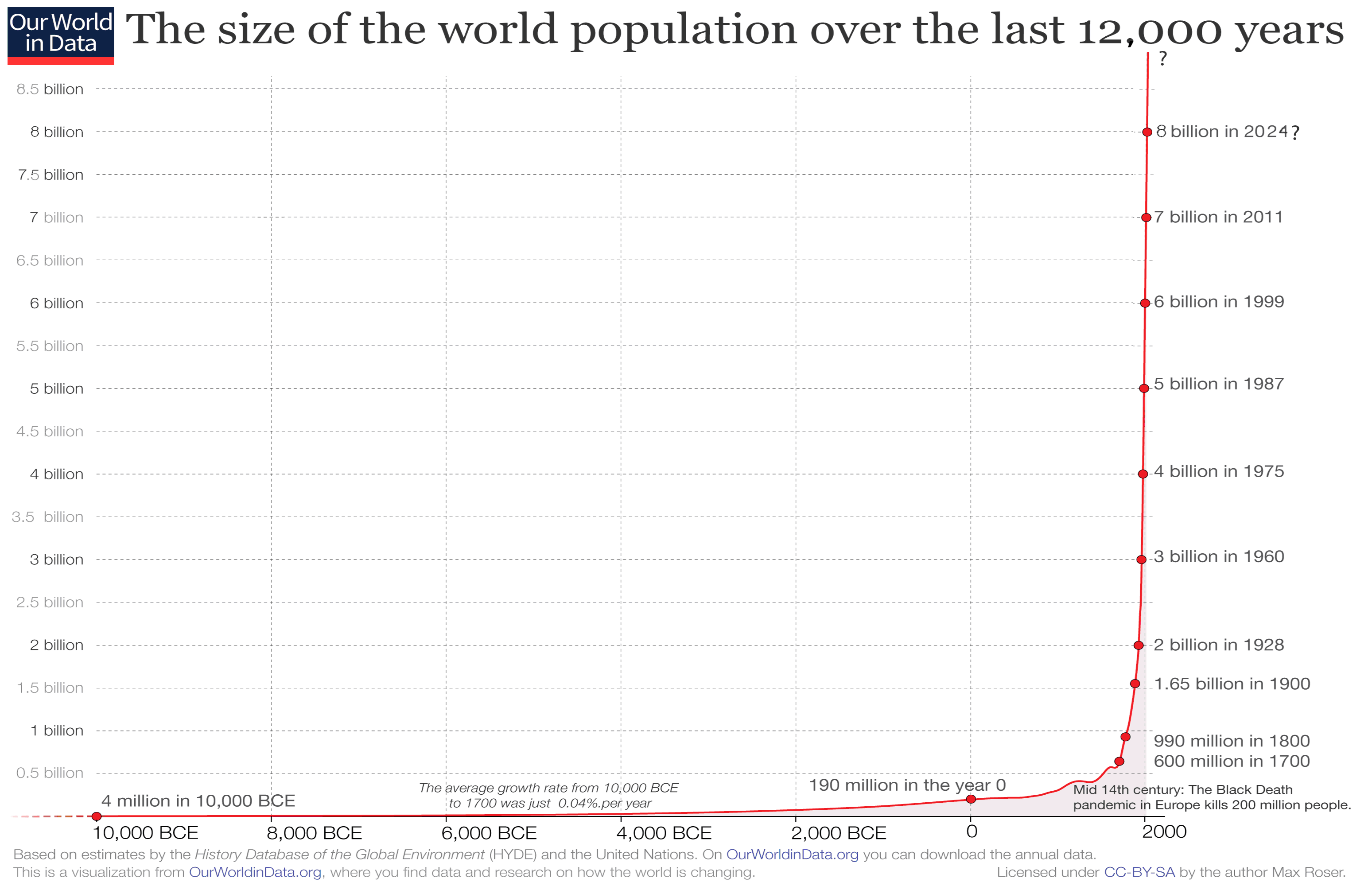
TUESDAY, FEB 26, 2019: NOTE TO FILE

Critical Mass
A film on population issues
Eric Lee, A-SOCIATED PRESS
TOPICS: POPULATION ISSUES, FROM THE WIRES, FILM TRANSCRIPT
Abstract: Feature films considering existential concerns of scientists are as rare as those humans who would rather know than believe. "Doomer" concerns are ignored, marginalized or denied outright. Malthusian doomers are especially reviled. John B. Calhoun and his "rats of NIMH" experiments, which involved putting rats and mice in an arbitrary and unnatural context, is an alternative source of existential concerns for humans in complex techno-industrial societies, aka human zoos. Even if concerns related to energy and material shortages could be dismissed as humans "decouple" from Nature, complex societies may develop increasing complexities that lead to a "behavioral sink" effect and irreversible loss of functional behaviors over the span of less than a dozen generations as pathologies accumulate and lead to extinction.
COOS BAY (A-P) — This is a transcript of a feature-length 2012 documentary by Mike Freedman intended for global distribution. About 60 scientists, academics, authors, activists and advisors were interviewed, over 200 hours were compressed to one hour of mostly talking heads, with some musical and visual interludes, with 42 surviving the final cut. It is about population, as in human population as it reaches critical mass. The science of John B. Calhoun is featured, with a supporting cast that includes William Rees, Desmond Morris, Joseph Tainter, Herman Daly, video clips of Norman Borlaug and M. King Hubbert among others.
I had been researching along the lines this film deals with for four years before I chanced to come across mention of it. I'll infer that the film, the only high-quality professional production I know of dealing with existential issues facing humanity, is one that almost no one has seen or heard of. I read one review and an interview, then rented a streaming version to view online which was good for 48 hours. I didn't watch it, knowing that I'd rather read and would need a transcript to vet the content, and as I couldn't find one, I spent about 25 hours with subtitles turned on and audio off stepping through the film a few seconds at a time while I typed. I also captured screen shots of the speakers in an attempt to keep their image matched with their name. Late on the second day my wife, a guest, and I watched it.
I had thought to figure out how to pirate a copy to share the information, all of which the speakers had offered freely, but why bother? The filmmaker should upload the film to Pirate Bay as post-release word-of-mouth increases revenue as some who hear about the film will pay to view (Mike, become a kopimist and upload your film). The film was never distributed. Rotten Tomatoes knows it exists, but there are no reviews. IMDB offers a synopsis and one "user" review. It wasn't even released on DVD. Not because it is not professionally, award-winningly made, but few will find the content entertaining overall, so it ain't got what 99.9+% of humans in industrial society want. This film will never go viral on Facebook, and if mentioned, who would Like or Share it on social media? It was mentioned on Reddit by title only and there were three brief comments with one offering a link to a YouTube video of Calhoun and his Mouse Utopia that is not pay-walled. One blogger reviewed the film, and there is a Stanford associated audio interview of the film maker. And th-th-th-that's all folks! The following YouTube video offers a far better overview of Calhoun's science and concerns (as distinct from politicized interpretations): The Mouse Utopia Experiments.
Still, the information value is high, perhaps priceless. Those reading the transcript are likely to spend $3 to $5 to view it, though I didn't find viewing the film entertaining nor actually informative as there was too much information to process in real time even though most was well plowed material I was familiar with. While the film was shown at seven film festivals and received an award, the content may not be of the sort that enthusiasts share or think about after seeing it. Critical Mass premiered at Biografilm Festival 2012, Italy, and made an appearance at a half dozen other film festivals in 2012 to 2013. One award: Newport Beach Film Festival 2013, Winner: Outstanding Achievement in Filmmaking - Environmental.
None of the thoughts I had had while transcribing arose in the blur of viewing it, though the vintage video of Calhoun and what authors looked like in person that I had only read helped turn them into persons, and so was worth the viewing. The ultimate value of the film may be that some small fraction of the few who view it will be motivated to read the books many of the speakers are associated with/known for or otherwise look into the issues. The issues involved can't be considered in much less than a lifetime. The thoughts of the scientists, who had spent the better part of a life listening to Nature, were of high value. Some presenters, like Hans Rosling, are a distraction, while about half a dozen are part of the problem and should not have been included. Vet the sources, all of them, and all claims made. [Added info/comments in brackets.]
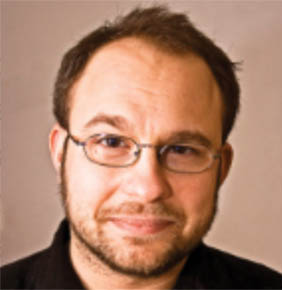
"I [John B. Calhoun] shall largely speak of mice, but my thoughts are on man, on healing, on life and its evolution. Threatening life and evolution are the two deaths, death of the spirit [élan vital, life-driven purposeful behavior of an evolvable subsystem] and death of the body [individual organism]. Evolution, in terms of ancient wisdom, is the acquisition of access to the tree of life. This takes us back to the white first horse [Conquest, the other three being War, Famine, and et al. premature Death (recently joined by the fifth—Misinformation)] of the Apocalypse which with its rider set out to conquer the forces that threaten the spirit [e.g. a viable population/species as viable subsystem] with death.... [empire building, i.e. the modern form of expansionist human, is death by conquest of conquered (both other humans and Nature, e.g. megafauna, resources for the taking), then following a delay, the conquerer dies by dissipation/conquest/overshoot—the first death/extinction of a population/species]."
[Above is intro to Death Squared: The Explosive Growth and Demise of a Mouse Population, a 1973 article by John B. Calhoun in the Journal of the Royal Society of Medicine. Calhoun's concern, why his thoughts were on man, is the understanding that humans are not different in kind from mice ('mere animals'), and that extinction is the pathway modern overdensity living humans are enthusiastically treading. He is forced to speak in religious metaphor as his concerns are on healing our pathological condition, on life and its evolution (posterity's persistence which will involve renormalizing modern humans). His proximal message (as is mine) is to the few who may know enough to understand his concerns for humanity, but his distal message is to humanity, hence the use of metaphor. In all cases the dynamic of overdensity overshoot, his rat and mouse societies, selected for their extinction, which is not a metaphor but a cautionary tale. The condition of not listening has a foreseeable outcome.]
Note: One pixel on high-res monitor = ten years.
In 100 years where will the red line be?
Is 0 billion possible?
How high will it have gone?"Conclusion:" [of Death Squared]
"The results obtained in this study [of Mouse Universe 25] should be obtained when customary causes of mortality become markedly reduced in any species of mammal whose members form social groups [hu-mans, he is talking about you]. Reduction of bodily death (i.e. "the second death') culminates in survival of an excessive number of individuals that have developed the potentiality for occupying the social roles characteristic of the species. Within a few generations all such roles in all physical space available to the species are filled. At this time, the continuing high survival of many individuals to sexual and behavioural maturity culminates in the presence of many young adults capable of involvement in appropriate species-specific activities. However, there are few opportunities for fulfilling these potentialities. In seeking such fulfillment they compete for social role occupancy with the older established members of the community. This competition is so severe that it simultaneously leads to the nearly total breakdown of all normal behaviour by both the contestants and the established adults of both sexes. Normal social organization (i.e. 'the establishment') breaks down, it 'dies'." [i.e. we become humans of NIMH, as we have]
"Young born during such social dissolution are rejected [neglected] by their [self-absorbed] mothers and other adult associates. This early failure of social bonding becomes compounded by interruption of action cycles due to the mechanical interference resulting from the high contact rate [but low repeated contact with the same individuals] among individuals living in a high density population. High contact rate further fragments behaviour as a result of the stochastics [random variable or process] of social interactions which demand that, in order to maximize gratification from social interaction, intensity and duration of social interaction must be reduced in proportion to the degree that the group size exceeds the optimum [of less than Dunbar's number]. Autistic-like creatures, capable only of the most simple behaviours compatible with physiological survival, emerge out of this process. Their spirit has died ('the first death'). They are no longer capable of executing the more complex behaviours compatible with species survival. The species in such settings die." [Interactions exceeding the optimum undermines human ability to trust, see Copykittens and Trust, and play the game/simulation.]
"For an animal so simple as a mouse, the most complex behaviours involve the interrelated set of courtship, maternal care, territorial defense and hierarchical intragroup and intergroup social organization. When behaviours related to these functions fail to mature, there is no development of social organization and no reproduction. As in the case of my study reported above, all members of the population will age and eventually die. The species will die out. "
"For an animal so complex as man, there is no logical reason why a comparable sequence of events should not also lead to species extinction [emphasis added]. If opportunities for role fulfillment fall far short of the demand by those capable of filling roles, and having expectations to do so, only violence and disruption of societal organization can follow. Individuals born under these circumstances will be so out of touch with reality [post-truth?] as to be incapable even of alienation. Their most complex behaviors will become fragmented. Acquisition, creation and utilization of ideas appropriate for life in a post-industrial cultural-conceptual-technological society will have been blocked. Just as biological generativity in the mouse involves this species' most complex behaviours, so does ideational [memetic] generativity for man. Loss of these respective complex behaviours means death of the species."
"Mortality, bodily death = the second death [the normal and necessary death of phenotypes that enables species, genomes, to be evolvable]
Drastic reduction of mortality [births>deaths, resulting in an overshoot population]
= death of the second death [failure to maintain population under carrying capacity, resulting in posterity's death by overshoot debt]
= death squared
= (death)2
(Death)2 leads to dissolution of social organization
= death of the establishment
Death of the establishment leads to spiritual death [loss of viable function]
= loss of capacity to engage in behaviours essential to species survival
= the first death [functional behaviors are a precondition for evolvable life which comes first, so such death is a first death]
Therefore: (Death)2 = the first death. [failure to renormalize, recover capacity to engage in behaviours essential to species survival, is species extinction, first by a loss of functionality followed by bodily death]
Happy is the man who finds wisdom [sapience],
and the man who gains understanding [precondition for memetic/cultural social auto-control limiting human demands on Nature's resources].
Wisdom is a tree of life to those who lay hold of her.
All her paths [towards renormalization] lead to peace [adaptation/persistence].
—(Proverbs iii.13, 18 and 17, rearranged)"]
—John B. Calhoun [Death Squared, 1973]
[To understand something (e.g. system dynamics, death2) is to be delivered from it. —Spinoza]
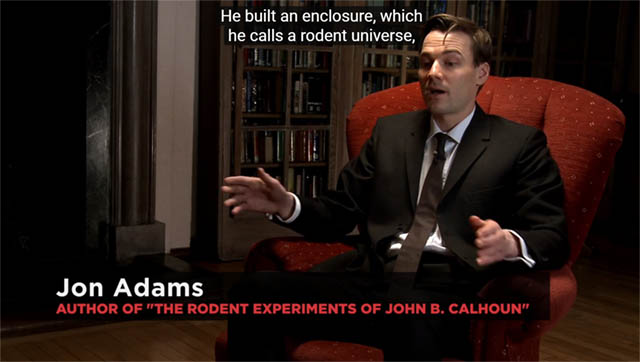 0:20
Jon Adams, author of "The Rodent Experiments of John B. Calhoun.pdf":
Two and a half years ago we found Dr. John Calhoun knee deep in mice
in the mouse heaven he designed for the National Institute of Mental
Health near Washington. Dr. Calhoun wanted to find out what would
happen to a mouse colony given everything mice need, except living
space. He
built an enclosure, which he calls a rodent universe, in a disused
barn.
0:20
Jon Adams, author of "The Rodent Experiments of John B. Calhoun.pdf":
Two and a half years ago we found Dr. John Calhoun knee deep in mice
in the mouse heaven he designed for the National Institute of Mental
Health near Washington. Dr. Calhoun wanted to find out what would
happen to a mouse colony given everything mice need, except living
space. He
built an enclosure, which he calls a rodent universe, in a disused
barn.
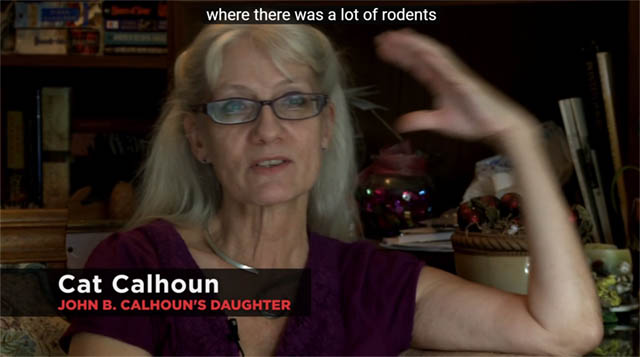 0:35
Cat Calhoun, John B. Calhoun's daughter: I don't know if you've ever
been anywhere where there was a lot of rodents in an enclosed space,
but it's real heavy on the rodent smell. When you came up the stairs
it was just their office area, which I remember as being rather
cramped and, you know, just desks and file cabinets and stuff. And
then you opened the door into the main area. There was a glass
window, observation window, for each of the little mini rooms. So you
could go up the stairs and lie down on the roof and watch the rats
from above, which was fun. [chuckles]
0:35
Cat Calhoun, John B. Calhoun's daughter: I don't know if you've ever
been anywhere where there was a lot of rodents in an enclosed space,
but it's real heavy on the rodent smell. When you came up the stairs
it was just their office area, which I remember as being rather
cramped and, you know, just desks and file cabinets and stuff. And
then you opened the door into the main area. There was a glass
window, observation window, for each of the little mini rooms. So you
could go up the stairs and lie down on the roof and watch the rats
from above, which was fun. [chuckles]
1:11 Jon Adams: He put rats into this enclosure, which was effectively four separate pens. He wanted to control space, to control the ways in which the rats accessed one another, the way in which they would bump into each other.
1:23 NARRATOR, voice of John B Calhoun: No jumper connects pens one and four, therefore there are two end pens and two center pens, two and three.
1:36 Jon Adams: He supplies ample bedding, he supplies ample food, he supplies ample water, and these rats want for nothing.
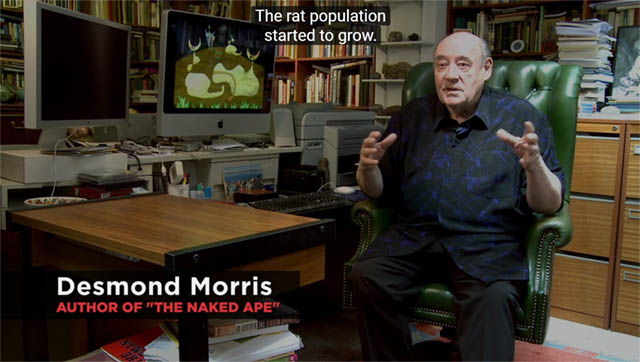 1:43
Desmond Morris, [zoologist, ethologist and surrealist painter,] author of "The Naked Ape" [and "The
Human Zoo"]: The rat population started to grow. Now in the wild
it would have spread out, or there would have been predators present.
But here there were no predators, and no possibility of spreading
out.
1:43
Desmond Morris, [zoologist, ethologist and surrealist painter,] author of "The Naked Ape" [and "The
Human Zoo"]: The rat population started to grow. Now in the wild
it would have spread out, or there would have been predators present.
But here there were no predators, and no possibility of spreading
out.
1:54 Jon Adams: There's a number of ways in which the way that he sets his experiments up lends themselves to being applied quite easily to the urban situations.
2:04 Desmond Morris: He was creating, essentially, an urban environment for his rats. It was like rat city.
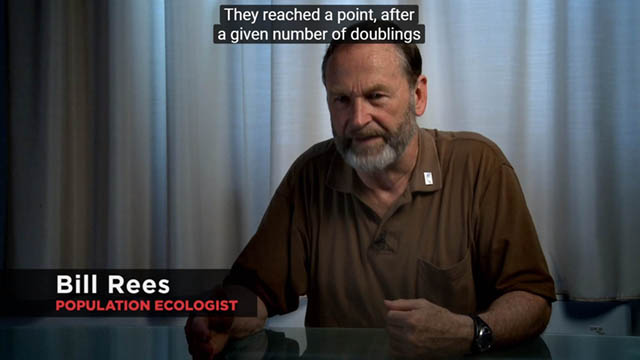 2:10
[William] Bill Rees, population ecologist [co-originator of the "ecological footprint" concept]: They reached a point,
after a given number of doublings in which behavior began to change
radically.
2:10
[William] Bill Rees, population ecologist [co-originator of the "ecological footprint" concept]: They reached a point,
after a given number of doublings in which behavior began to change
radically.
2:16 Jon Adams: And this is where the experiments really get pretty interesting.
2:20 A Day 600 Production. A Mike Freedman Film. Freedman is NARRATOR: Like you, I live in a world filled with other people. It seems impossible to find a place on Earth untouched by human hands. How does this human world affect us? How did we get here, and where are we going?
3:06 NARRATOR: As with any story, it's best to begin at the beginning. In this 18-cell mouse habitat, utopian conditions of nutrition, comfort, and housing were provided for a potential population of over 3,000 [3840]mice. The mouse universe simulated the present situation of the continually expanding population of humans.
3:29 Desmond Morris: Human beings evolved as tribal animals living in small groups of maybe 100, 200 individuals. [Tribe: several related bands of 5 to 85 individuals who occasionally met up to exchange genes and memes.]
3:37 William Rees: You might meet 50, perhaps 200 people max, in the course of your lifetime.
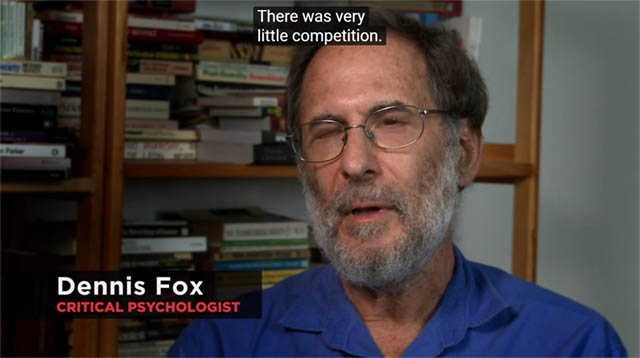 3:41
Dennis Fox, critical psychologist [The term critical psychology refers to a variety of approaches that challenge mainstream psychology's assumptions and practices that help sustain unjust political, economic, and other societal structures.]: There was very little competition.
There was very little pressure. If people were getting too close you
could, your group could go someplace else.
3:41
Dennis Fox, critical psychologist [The term critical psychology refers to a variety of approaches that challenge mainstream psychology's assumptions and practices that help sustain unjust political, economic, and other societal structures.]: There was very little competition.
There was very little pressure. If people were getting too close you
could, your group could go someplace else.
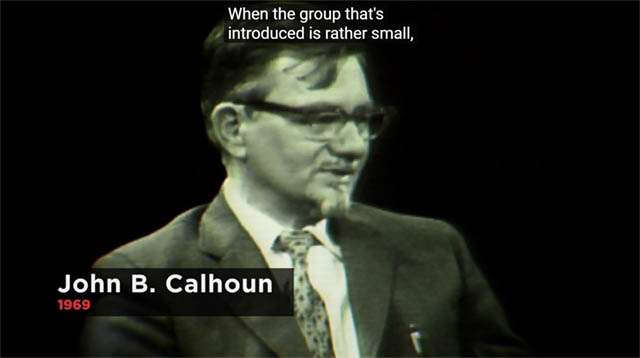 3:51
John B. Calhoun [an American ethologist and behavioral researcher noted for his studies of population density and its effects on behavior. He claimed that the bleak effects of overpopulation on rodents were a grim model for the future of the human race]: When the group that's introduced is rather small,
each individual can move around and associate with his physical
environment, and he sort of incorporates them into himself, that
these are part of him, his ego boundaries. This is what I am.
3:51
John B. Calhoun [an American ethologist and behavioral researcher noted for his studies of population density and its effects on behavior. He claimed that the bleak effects of overpopulation on rodents were a grim model for the future of the human race]: When the group that's introduced is rather small,
each individual can move around and associate with his physical
environment, and he sort of incorporates them into himself, that
these are part of him, his ego boundaries. This is what I am.
4:07 NARRATOR: Within the first 100 days the mice went through the period Dr. Calhoun called strive. This was a period of adjustment. Territories were established and nests were made.
4:20 : If a particular tribe was successful it would split off and another tribe would develop, and in that way, we fanned out to cover the whole land surface, pretty well, of the planet.
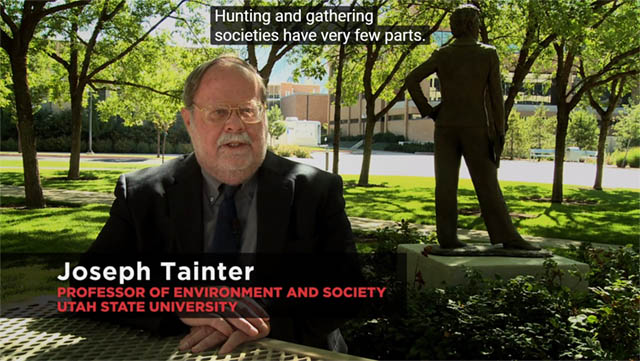 4:31
Joseph Tainter, professor of environment and society Utah State
University [and author of The Collapse of Complex Societies, societies collapse when their investments in social complexity and their "energy subsidies" reach a point of diminishing marginal returns.]: Hunting and gathering societies have very few parts.
Pretty much everyone follows the same rules and the same occupations.
4:31
Joseph Tainter, professor of environment and society Utah State
University [and author of The Collapse of Complex Societies, societies collapse when their investments in social complexity and their "energy subsidies" reach a point of diminishing marginal returns.]: Hunting and gathering societies have very few parts.
Pretty much everyone follows the same rules and the same occupations.
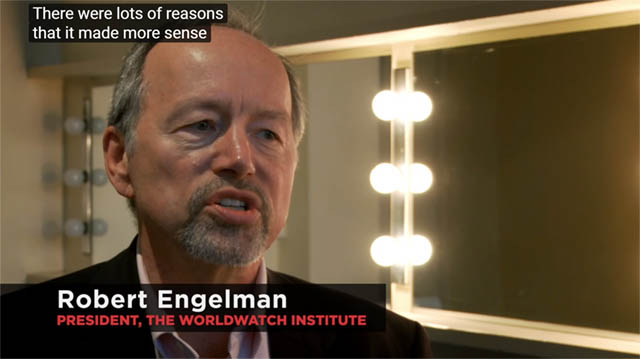 4:39
Robert Engelman, president, The Worldwatch Institute [former journalist who writes about the environment and population]: There were lots
of reasons that it made more sense for women and men to have similar
interests. You couldn't really move too many people around easily.
4:39
Robert Engelman, president, The Worldwatch Institute [former journalist who writes about the environment and population]: There were lots
of reasons that it made more sense for women and men to have similar
interests. You couldn't really move too many people around easily.
4:46 Fox: We didn't have agriculture, we didn't have possessions. We relied upon each other on a daily basis.
4:54 Calhoun: in the early primitive hunter group they had about 15,000 years to solve their impasse when they were stuck by the carrying capacity of the environment.
5:04 Fox: And then about 10,000 years ago, the story goes, we came up with agriculture.
5:09 : Then we had, for the first time in our long history, a food supply, a food surplus.
5:18 Fox: Agriculture brought with it larger accumulations of people living in one place, the ability to support people who weren't directly engaged in the hunting/gathering, or farming small scale for themselves.
5:36 : This kind of agricultural existence that we had now developed changed our personalities.
5:44 Fox: Because of this accumulation, people were no longer living this egalitarian, carefree existence. There was hard work, possessiveness, and royalty, and poor people, and maybe slaves.
5:59 Engelman: Suddenly relationships between men and women were changing very dramatically, and leaders evolved, hierarchy evolved.
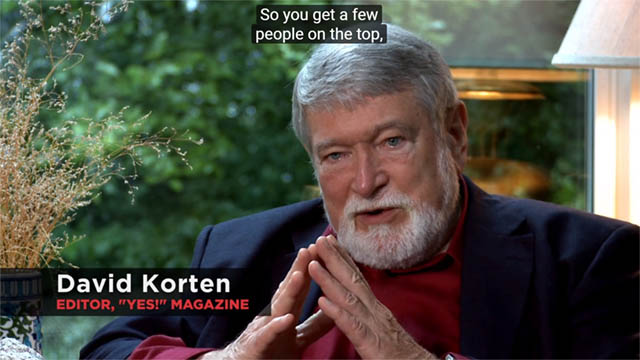 6:06
David Korten, editor, "Yes!" magazine [author, former professor of the Harvard Business School, political activist, prominent critic of corporate globalization, and "by training and inclination a student of psychology and behavioral systems"]: So you get a few
people on the top, you get most people on the bottom, and more and
more of our resources went in to maintaining the system of domination.
[A political, not science-based POV of the what-is.]
6:06
David Korten, editor, "Yes!" magazine [author, former professor of the Harvard Business School, political activist, prominent critic of corporate globalization, and "by training and inclination a student of psychology and behavioral systems"]: So you get a few
people on the top, you get most people on the bottom, and more and
more of our resources went in to maintaining the system of domination.
[A political, not science-based POV of the what-is.]
6:16 Calhoun: This dominant male maintains pen one as his territory, to the near exclusion of all other males. He moves freely about pen one. He examines and enters the artificial burrow which houses his harem of adult females.
6:38: Engelman: More hierarchy, more male leadership, and a clearer idea that women were possessions. They weren't partners, they weren't suddenly fertility goddesses, which we see in the paleolithic. Suddenly they became property for men.
6:51 Joseph Tainter: Hierarchy didn't simply come about because people accepted it, it came about because [the SYSTEM of complex empire-building societies, from chiefdoms to nation-states, selected for hierarchy] circumstances made it necessary, and those circumstances were probably rising populations.
7:02 : Villages grew into towns, and in towns specialists developed. The men making weapons, and jewelry, and clothing, and all kinds of arts and crafts, and scientific developments were occurring in these towns, and the towns grew into great cities. And, although I'm covering 1o,000 years in 10 seconds, that gave us, eventually, the urban world in which we live today.
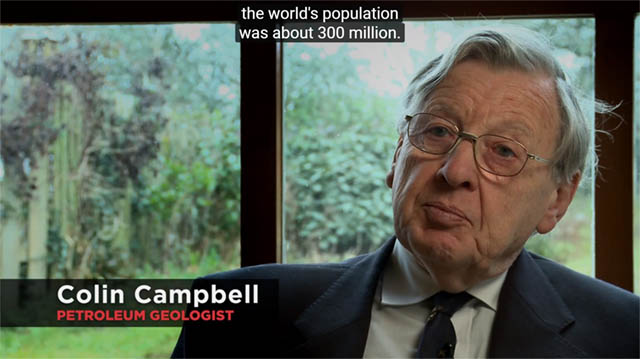 7:34
Colin Campbell, petroleum geologist [British petroleum geologist who predicted that global oil production would peak by 2007, but fracking has delayed peak oil. He claims the consequences of this are uncertain but drastic, due to the world's dependency on fossil fuels for the vast majority of its energy]: You know, at the time of Christ
the world's population was about 300 million. And the number only
doubled over 17 centuries.
7:34
Colin Campbell, petroleum geologist [British petroleum geologist who predicted that global oil production would peak by 2007, but fracking has delayed peak oil. He claims the consequences of this are uncertain but drastic, due to the world's dependency on fossil fuels for the vast majority of its energy]: You know, at the time of Christ
the world's population was about 300 million. And the number only
doubled over 17 centuries.
7:42 William Rees: 200,000 years to reach a quarter billion people. That's almost zero growth for 99% of the history of our species. Your ancient governments would usually encourage growth of population [as do modern SYSTEMs].
7:55 Joseph Tainter: Food for the cities, sons for the army, taxes for the state.
7:58 Adams: Cities begin to grow. Cities become the place where, through economic necessity, huge numbers of people flock.
8:06 Campbell: The industrial revolution that came in the beginning of the 18th century [1712 Newcomen steam engine], more or less. And coal fired it up in the first place, and then it was followed in mid-19th century by oil.
8:19 William Rees: We've had enormous growth in just the last couple of hundred years.
8:23 Colin Campbell: The population grew, tenfold, more or less in parallel with oil.
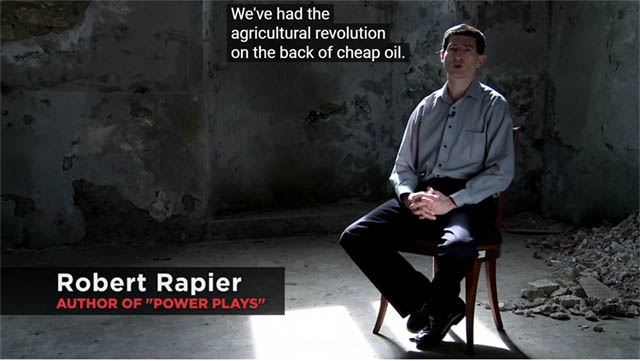
8:27 Robert Rapier, author of "Power Plays" [works in the energy industry and writes and speaks about issues involving energy and the environment. He is Chief Technology Officer and Executive Vice President at Merica International, a forestry and renewable energy company involved in a variety of projects around the world]: We've had the agricultural [Green] revolution on the back of cheap oil. I think the role of cheap oil has been understated in the explosion in the food production that we've had.
8:36 Campbell: Oil provides an enormous flood of easy energy. The equivalent of billions of slaves [about 100 slaves per person in industrial society] working round the clock, you could say. They're approaching population densities the likes of which humanity's never seen, and it's getting worse.
8:50 Joseph Tainter: A higher population density means that a society has to be more complex, simply to integrate the large number of people.
8:58 Adams: There's this increasingly urgent problem of how do you house all the people which are now moving to the cities.
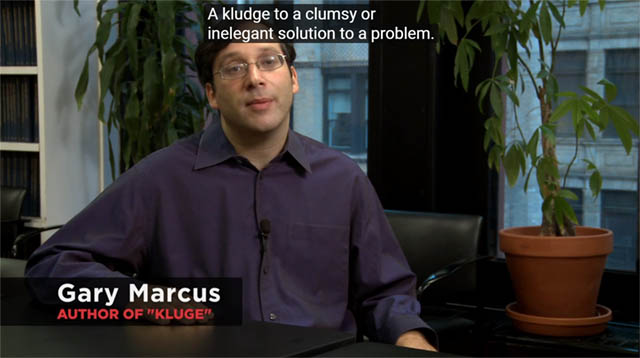 9:03
Gary Marcus, author of "Kluge" [scientist, author, and entrepreneur. His research focuses on natural and artificial intelligence. Marcus is a Professor in the Department of Psychology at New York University and was Founder and CEO of Geometric Intelligence, a machine learning company later acquired by Uber]: A kludge to a clumsy or
inelegant solution to a problem. You can think MacGyver, or duct tape
and rubber bands. Something that gets the job done, but not
necessarily in the most efficient or elegant fashion that you can
possibly imagine. They start building tower blocks, into which you
can stack more people.
9:03
Gary Marcus, author of "Kluge" [scientist, author, and entrepreneur. His research focuses on natural and artificial intelligence. Marcus is a Professor in the Department of Psychology at New York University and was Founder and CEO of Geometric Intelligence, a machine learning company later acquired by Uber]: A kludge to a clumsy or
inelegant solution to a problem. You can think MacGyver, or duct tape
and rubber bands. Something that gets the job done, but not
necessarily in the most efficient or elegant fashion that you can
possibly imagine. They start building tower blocks, into which you
can stack more people.
9:18 Adams: So you start seeing the first skyscrapers. The cities grow, in terms of sheer population numbers, they grow up, and so when a city's growing out a little bit it gets denser, and denser at the inner core.
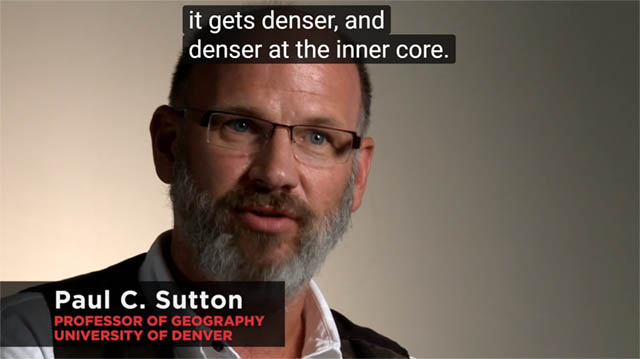 9:28
Paul C. Sutton, professor of geography, University of Denver [teaches geographic statistics, population geography, and ecological economics]: They
talk about these using the language of the beehive. Hives where you
can pack a great number of people and they'll live together, very
much in the manner of bees, cooperating, being productive.
9:28
Paul C. Sutton, professor of geography, University of Denver [teaches geographic statistics, population geography, and ecological economics]: They
talk about these using the language of the beehive. Hives where you
can pack a great number of people and they'll live together, very
much in the manner of bees, cooperating, being productive.
9:41 Adams: Many people mistakenly think that this is indicative of humanity's decoupling from Nature. What could possibly go wrong?
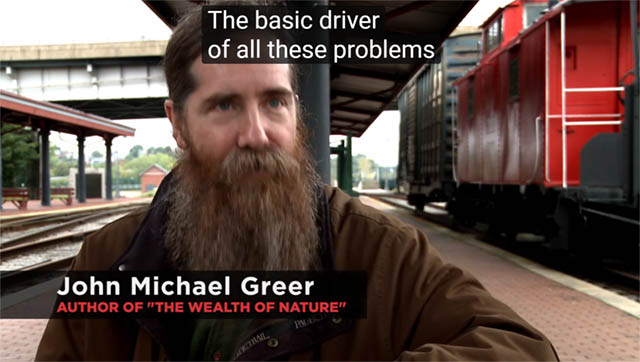 9:49
John Michael Greer, author of "The Wealth of Nature" [writes on the environment, various religions, and occult topics. He served from December 2003 to December 2015 as the Grand Archdruid of the Ancient Order of Druids in America, and since then has focused on the Druidical Order of the Golden Dawn, which he founded in 2013]: The
basic driver of all these problems is the attempt to have infinite
economic growth on a finite planet.
9:49
John Michael Greer, author of "The Wealth of Nature" [writes on the environment, various religions, and occult topics. He served from December 2003 to December 2015 as the Grand Archdruid of the Ancient Order of Druids in America, and since then has focused on the Druidical Order of the Golden Dawn, which he founded in 2013]: The
basic driver of all these problems is the attempt to have infinite
economic growth on a finite planet.
9:56 William Rees: This is a grotesque error, one that we'll rue in the long run.
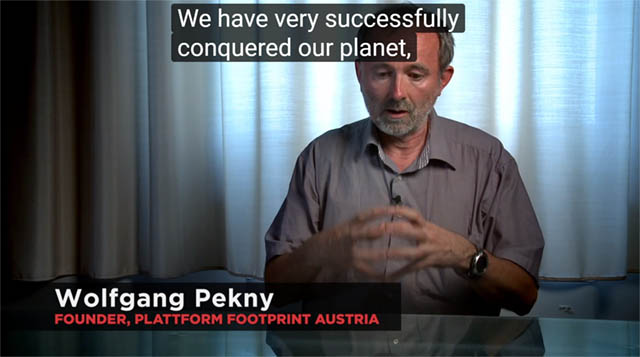 10:03
Wolfgang Pekny, founder, Platform Footprint Austria [activist . His main topics include biodiversity , commons , international law and life cycle assessments . Between 1975 and 1987 he studied chemistry and biology at the University of Vienna . In 2007, he founded the website www.footprint.at after having co-ordinated the strategic direction of Greenpeace- Austria for about 20 years . Since its inception (about 2006), he has been the chairman of the civil society initiative . In addition, since 2009, he has headed the management consultancy footprint-consult eU]: We have very
successfully conquered our planet, and by conquering the planet we
met at the other end.
10:03
Wolfgang Pekny, founder, Platform Footprint Austria [activist . His main topics include biodiversity , commons , international law and life cycle assessments . Between 1975 and 1987 he studied chemistry and biology at the University of Vienna . In 2007, he founded the website www.footprint.at after having co-ordinated the strategic direction of Greenpeace- Austria for about 20 years . Since its inception (about 2006), he has been the chairman of the civil society initiative . In addition, since 2009, he has headed the management consultancy footprint-consult eU]: We have very
successfully conquered our planet, and by conquering the planet we
met at the other end.
10:12 NARRATOR: It's a pretty impressive picture. The next period lasted about 250 days. The population of the mice doubled every 60 days. This was called the exploit period. When I [Freedman] was born, there were 3 billion people in the world.
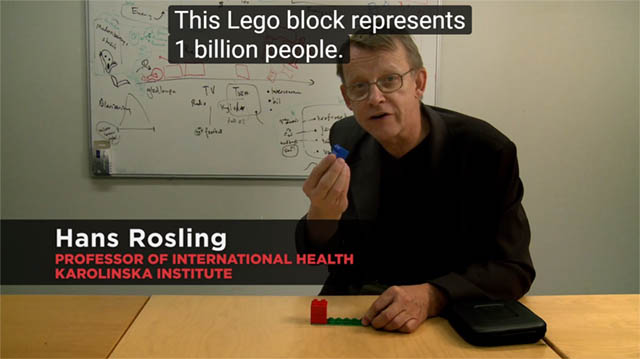 10:40
Hans Rosling, [Swedish MD and amateur statistic enthusiast, former]
professor of International Health, Karolinska Institute [co-founder and chairman of the Gapminder Foundation, which developed the Trendalyzer software system. He held presentations around the world, including several TED Talks in which he promoted the use of data to explore development issues]: This Lego
block represents 1 billion people.
10:40
Hans Rosling, [Swedish MD and amateur statistic enthusiast, former]
professor of International Health, Karolinska Institute [co-founder and chairman of the Gapminder Foundation, which developed the Trendalyzer software system. He held presentations around the world, including several TED Talks in which he promoted the use of data to explore development issues]: This Lego
block represents 1 billion people.
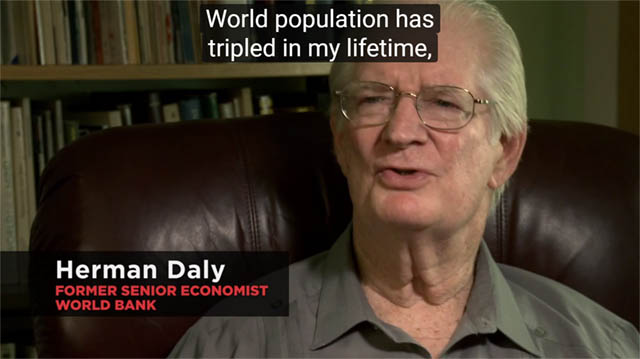 10:44
Herman Daly, former senior economist, World Bank [Before joining the World Bank, Daly was a Research Associate at Yale University, and Alumni Professor of Economics at Louisiana State University. As Senior Economist in the Environment Department of the World Bank he helped to develop policy guidelines related to sustainable development. While there, he was engaged in environmental operations work in Latin America. He is closely associated with theories of a steady-state economy. He was a co-founder and associate editor of the journal, Ecological Economics]: World population
has tripled in my lifetime, and I don't think that's ever going to
happen again, at least I hope it doesn't.
10:44
Herman Daly, former senior economist, World Bank [Before joining the World Bank, Daly was a Research Associate at Yale University, and Alumni Professor of Economics at Louisiana State University. As Senior Economist in the Environment Department of the World Bank he helped to develop policy guidelines related to sustainable development. While there, he was engaged in environmental operations work in Latin America. He is closely associated with theories of a steady-state economy. He was a co-founder and associate editor of the journal, Ecological Economics]: World population
has tripled in my lifetime, and I don't think that's ever going to
happen again, at least I hope it doesn't.
10:51 Rosling: When our teacher told us we are 3 billion people, she said that the Indian population and Chinese population will grow to become 1 billion, but everyone understands that that's impossible. Yeah, that's impossible, everyone said [not everyone]. We told our parents, they'd say, of course that's impossible, they will starve to death, that won't happen ["they" didn't foresee the Green Revolution].
11:09 NARRATOR: My grandfather was born in New York City, in 1914. In the previous 100 years the world's population had grown from 1 billion to 1.6 billion. Since my grandfather was born the world's population has gone from 1.6 billion to more than 7 billion. Slowly the indicator crept up the grandest grand total in the history of the United States, and there it was [200 billion]. "The signs show the dramatic increase [4 million USA population in 1790, 50 million in 1880, 100 million in 1915, 200 million in 1967] of America's population in under 200 years, and experts reckon that at the current rate of birth acceleration a 300 million total is possible by the turn of the [twentieth century."
11:49 NARRATOR: My grandparents had two children, my father and uncle. My father had three children, my uncle had four. My brother and sister each have one child. So from my two grandparents 100 years ago there are 11 people alive today. This is called the exponential function.
12:39 "Somewhere on this globe, every ten seconds, there is a woman giving birth to a child. She must be found and stopped." Sam Levenson 1911-1980
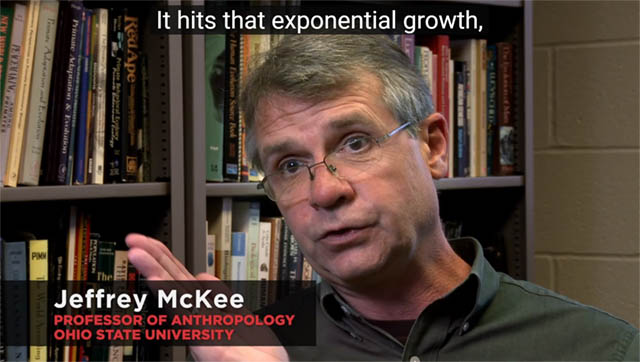 12:44
Jeffrey McKee, professor of anthropology, Ohio State University [physical anthropologist conducting research on hominid evolution and paleoecology]: It
hits that exponential growth, and then up until the industrial
revolution it keeps on going up and up and up. But with the
industrial revolution, the rate itself increases even more. And so we
go from something like, you know, a growth of 0.02% to a growth of
2%.
12:44
Jeffrey McKee, professor of anthropology, Ohio State University [physical anthropologist conducting research on hominid evolution and paleoecology]: It
hits that exponential growth, and then up until the industrial
revolution it keeps on going up and up and up. But with the
industrial revolution, the rate itself increases even more. And so we
go from something like, you know, a growth of 0.02% to a growth of
2%.
13:00 Rosling: Look 4 billion people more in the world, and at the same time industrialized countries, they grow much richer. And these 4 billion extra landed somewhere here, and 1 billion of them were very successful [consumers]. The emerging economy, the top of the emerging economy. We noted it in Sweden this year because China acquired the Volvo company.
13:22 NARRATOR: In 1971, the world's population growth rate peaked at 2.1%. In 2011, the growth rate was 1.2%. It seems like the population of the world is growing slower than it was, but in 1971, the world's population was just under 4 billion. A growth rate of 2.1% meant that 79 million new people were born that year. In 2011, the growth rate was 1.2%, but there are so many more people in the world that the number of new people born each year is almost the same [77 million]. new people are born every minute, 8,850 every hour, 212,000 every day. That adds up to 77 million a year. By the end of this film, there will be 15,000 more people in the world than there are now.
14:06 NARRATOR: But they couldn't care less what the figure is or will be. That's for the grownups to worry about. His main concern is not millions of mouths to be fed. Just one, his.
14:19 William Rees: The demographers missed the baby boom after World War II, and they [chuckles], they got ridiculed a bit for that. And so they've kind of stepped back from this idea of making predictions and they make projections. And there's usually a high, and a medium, which is sort of what they expect, and a low projection of what future population scenarios are.
14:39 Rosling: Population keeps growing while family size shrink, and the growth only stops 30 years after a country have hit two children per woman, because they are building up the middle age people and the old people in the population.
14:55 NARRATOR: Population growth is measured and projected using something called the total fertility rate, or TFR.
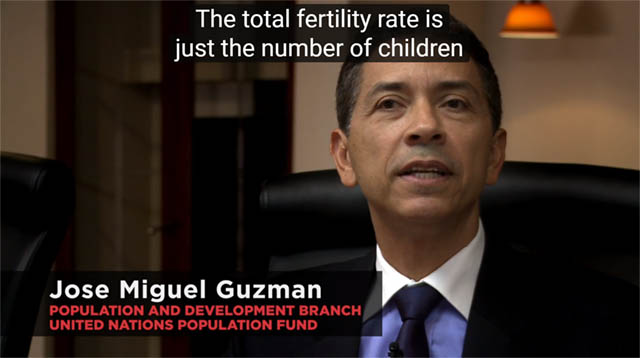
14:59 José Miguel Guzman, Population and Development Branch United Nations Population Fund [contribution to the understanding of population issues and their relevance for national policies and programmes. Contribution to demographic studies and to the improvement of public policy in the social domain spans several decades and covers a variety of issues, borne out in a publication list of more than 20 books and 50 articles]: The total fertility rate is just the number of children that women have in all their reproductive life. Let's say, from the beginning she'll start having children, to the end.
15:08 NARRATOR: The TFR for a stable world population is 2.33 children per woman. This is called replacement rate. High income countries, upper middle income countries, lower middle income countries, and low income countries.
15:21 Rosling: This pile [Legos] here have two children per woman. Two children per woman here, and also here. Vietnam, Mexico, Bangladesh, down to almost two children per woman. So this means that in just one or two decades more the population growth will stop here. The problem we have with population growth is entirely here in the two poorest billion. There is not vaccination for all children, so children are dying. So people have good reasons of getting many children. [Rosling's narrative leads to the popular and acceptable (to Anthropocene enthusiasts) view that more equitable economic growth and per ca-pita consumption, aka "progress," must continue, sustainably of course.]
15:48 Calhoun: Looking back at the historical record, and certain insights from mammals of the kind which man traces his lineage, had led to a conclusion that the optimum world population is 9 billion.
16:05 William Rees: They say 9 billion by 2050, and this is sort of UN estimates, and the UN has historically underestimated where we're going to, so we may be at more than 9 billion by 2050 [if we can keep on keeping on]. I don't think anybody thinks that's a good idea.
16:22 Rosling: Up to 2050 we cannot avoid another addition of 2 billions, but what will happen with these ones? I have no doubt that they will catch up here. That means more energy use, more consumption.
16:36 NARRATOR: In 2011, the world's TFR was 2.46 with a population of over 7 billion people. The UN population division projects that we can expect 9.3 billion people on the planet by 2050. That medium projection relies on the world's TFR falling to 2.02, a drop of 18%. At replacement level, 2.33, their high projection is almost 12 billion in 40 years, if we bring fertility rates down by 6%.
 17:05
Martha Madison Campbell, public health lecturer, University of California at Berkeley [long been interested in world population growth, women’s empowerment, and issues of scale. With Dr. Ndola Prata and Potts she published in 2012 “The Impact of Freedom on Fertility Decline,” their paradigm explaining the slowing of population growth in a human rights framework. Has written and presented on the widespread silence about the population subject since the 1990s, and the costly results around it]: If women have, on
average, 2.1 children you could end up with that 9 billion people out
to the year 2300, but if you add just a third of a child more you end
up with 36 billion people by 2300. That is the power of compound
interest, if you will.
17:05
Martha Madison Campbell, public health lecturer, University of California at Berkeley [long been interested in world population growth, women’s empowerment, and issues of scale. With Dr. Ndola Prata and Potts she published in 2012 “The Impact of Freedom on Fertility Decline,” their paradigm explaining the slowing of population growth in a human rights framework. Has written and presented on the widespread silence about the population subject since the 1990s, and the costly results around it]: If women have, on
average, 2.1 children you could end up with that 9 billion people out
to the year 2300, but if you add just a third of a child more you end
up with 36 billion people by 2300. That is the power of compound
interest, if you will.
17:23 Rosling: These 3 billions, which is like Vietnam today, Peru today, they want to move here. Here we will get 2 billion extra. If these ones remain in poverty when we reach 2050, then they will continue to grow. But if they get access to school, health care, family planning, perhaps an electric bulb, yes, in their home, they will also get two child families, and then in 2050, we can stop at 9 billion.
17:54 NARRATOR: The third period, consisting of 300 days, found a population of mice leveling off. This was called the equilibrium period.
18:03 Rosling: And there’s nothing we can do about this 9 billion if we’re not going to kill people at a scale that hasn’t happened in modern history, and I’m talking about centuries, and thousands of years. We have to plan for 9 billion. And don’t think that people should live in poverty, because then they will continue to grow, and don’t even think that people who have a bicycle don’t want washing machines.
18:26 NARRATOR: And how are we doing with the 7 billion people we have now?
 18:33
Peter Gleick, academician, International Water Academy [scientist working on issues related to the environment. He works at the Pacific Institute in Oakland, California, which he co-founded in 1987. In 2003 he was awarded a MacArthur Fellowship for his work on water resources]: Badly.
[chuckles]
18:33
Peter Gleick, academician, International Water Academy [scientist working on issues related to the environment. He works at the Pacific Institute in Oakland, California, which he co-founded in 1987. In 2003 he was awarded a MacArthur Fellowship for his work on water resources]: Badly.
[chuckles]
18:37 NARRATOR: At this time, some unusual behavior became noticeable.
18:47 Calhoun: In order to consider physical space and the crowding together, you cannot separate it from the ability to deal with the social organization.
18:52 Cat Calhoun: If you’ve watched these animals in the wild, and studied them, which he had, you know what their normal behavior is. You know how they normally react. You can tell whether what they’re doing there is normal or not, how much it deviates from the norm, and as the population grows you can see the changes.
19:14 William Rees: Desmond Morris, I think, was one to make the point that we actually don’t know how humans behave in nature because we haven’t been in nature for as long as we’ve been making these kinds of records, right? Cities are abnormal phenomena, in the sense that for 99% of human history they haven’t existed.
19:29 Adams: There was this sense out there that people already had, that if you crowd mammals together, they’ll behave aggressively. That people in crowded environments will become more violent, will become stressed.
INTERVIEWER: God almighty. Sorry man, please, we’re filming. Can, no, please. I’m sorry man, that’s in shot. Thanks. How long you gonna be? Intelligibility’s on the door, we’re here till five.
19:56 Calhoun: This is his bubble, and when another mouse comes into that boundary, then it’s as if he was hit physically. His anxiety builds up. It may be an overt fight, as a reflection of the stress of this individual’s space bubble being invaded. One rarely sees more than one rat at a time eating or drinking. As the breeding population reaches a certain level of density, he starts noticing aberrant behaviors.
20:28 : It reached a point where they could no longer function as rats.
20:33 Calhoun: In the center pens, two and three, rats frequently drink beside each other, as they do here in pen three at the lower left. Note how this female comes over to drink beside another, as do these two males. The act of drinking becomes associated with the presence of others.
20:56 Adams: He starts noticing something called pathological togetherness. Despite the fact there’s plenty of food hoppers and water bottles available, all the rats will congregate around one of them. They won’t spread out and keep themselves to themselves. They start displaying these really unnatural and peculiar responses. Human beings evolved living in huge areas, as a tribe of say 60, or big tribe, 200 people.
21:21 : When I looked then at the population of London, or New York, I realized that the population density of our species had increased by 100,000 times since our original tribal life. And it was that tribal life, that was where we evolved, and that’s how our personality was formed.
21:42 Calhoun: The mice have programs, they’re like little computers, and this is basically genetic with a much smaller element of learned behavior. And too high a contact rate disorganizes the program so that it gets washed out, so it’s disconnected, so it doesn’t express itself.
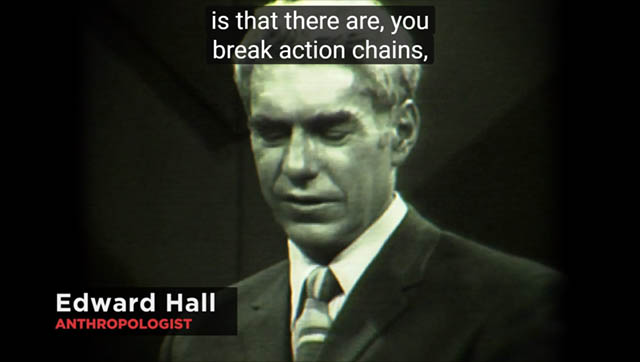 22:06
Edward Hall, anthropologist on old video [remembered for developing the concept of proxemics and exploring cultural and social cohesion, and describing how people behave and react in different types of culturally defined personal space. Hall was an influential colleague of Marshall McLuhan and Buckminster Fuller]: Well, that’s one of
the consequences of overcrowding is that there are, you break action
chains, and the very simple example is a woman goes to the, leaves
her apartment going to the grocery store, or to the drug store with
certain things in mind that she’s going to buy. She gets too
many interruptions of the wrong type, she’s going to forget what
she went to buy, and if she gets enough of them she’s likely to
forget that she was even going to go to the store. And all life is
made up of action chains. Some of them are incredibly complex.
22:06
Edward Hall, anthropologist on old video [remembered for developing the concept of proxemics and exploring cultural and social cohesion, and describing how people behave and react in different types of culturally defined personal space. Hall was an influential colleague of Marshall McLuhan and Buckminster Fuller]: Well, that’s one of
the consequences of overcrowding is that there are, you break action
chains, and the very simple example is a woman goes to the, leaves
her apartment going to the grocery store, or to the drug store with
certain things in mind that she’s going to buy. She gets too
many interruptions of the wrong type, she’s going to forget what
she went to buy, and if she gets enough of them she’s likely to
forget that she was even going to go to the store. And all life is
made up of action chains. Some of them are incredibly complex.
22:34 : You imagine going down the street, and saying “Good morning, hello, how are you,” to every person you passed. It would be crazy. It would be a ridiculous situation. So what we do is we make all but our little tribe [Dunbar’s number] into non-people, and we’re able to continue as tribesmen, which is how we evolved, within the super tribe of the city, and that’s what enables us to survive in these huge conglomerations.
23:23 NARRATOR: Each animal became less aware of associates, despite all animals being pushed closer together. Dr. Calhoun concluded that the mice could not effectively deal with the repeated contact of so many individuals.
23:38 : There are people who say it was a concrete jungle, but jungles aren’t like that. This was a zoo where we’re kept in small cages in this urban environment.
23:46 William Rees: It’s probably fair to say that we are inherently maladapted to the large kind of urban landscapes in which most people live today. Something about the urban environment is changing the way that people behave. One of the theories at the time is that there’s a miasma effect.
24:05 Adams: When you bring all these people together, not only do they become a vector for one another’s diseases, and of course you have epidemics of cholera, typhoid in cities, but also they become a vector for one another’s vices.
24:16 Calhoun: After being attacked, this socially withdrawn male 29, makes a pan sexual approach to male 16, who he recently saw attacked. Note how one assumes the female role.
24:31 Adams: Males exhibit sexual behavior towards other males, you have rat homosexuality, they begin mounting the young.
24:40 Calhoun: Associated with his social withdrawal, his pan sexual mounting of juvenile male.
24:47 Adams: Gangs of males will attack a single female, mounting her repeatedly.
24:52 Calhoun: Here, male 78, forcefully grasps estrus female 123, and hold on. I call these frog mount. They may last minutes, rather than the normal one to three seconds. Females occasionally exhibit pan sexual behavior. Here female 47 attempts to mount dominant male 35, who resents her approaches. Though living with many males she rarely conceived.
25:28 Adams: Here is an animal which doesn’t have a society in the sense that people do, and nonetheless seems to be behaving in the way that people do when they’re in cities. It’s 1962, there’s increasing concerns with overpopulation. There’s concerns, in particular, with urban decay.
25:50 NARRATOR: Newark, New Jersey, became a city of race riots, violence, looting, and hate. For five days it was a battleground and a looter’s paradise. Similar riots in other American centers with hatred near danger point between white and black extremist groups.
26:08 Adams: Journalists and writers, fiction writers in particular, see this as a consequence of the mass of people. Which is to say, it’s not just that there were more people, and therefore there was more crime. Something was happening in the cities that was changing the way people behaved.
26:24 Joseph Tainter: Complex societies have many different kinds of parts. We have many kinds of technologies, we have many social roles and institutions. People specialize in these roles, people specialize in occupations.
26:37 NARRATOR: Dr. Calhoun noticed that the newer generations of young were inhibited. Since most space was already socially defined violence became prevalent. The males on the floor here who are withdrawn, they are highly stressed animals. But the stress comes from each other because of this peculiar violence that they exhibit which leaves them as this animal, with his tail all chewed up, but they do it to each other. These are highly stressed individuals.
27:11 Adams: As the chaos within these enclosures becomes more and more pronounced you’ll have rats which move away from the group, set up on a little perch by themselves all day and only come down to feed at night or when there’s no one else around. Increasingly even this becomes difficult to do. He calls it social autism.
27:30 Calhoun: The way that man differs is that he learned something early, very early in his beginning cultural history, and this was to develop new roles.
27:45 Joseph Tainter: This is what we mean by complexity. An increasing number of parts, and an organization to make those parts work together as a society.
27:53 Calhoun: And in this way the population can increase, the number of people in a particular area, provided you can develop codes that say how, how you operate in the social contract so that you interact with these people and not those people.
28:11 Cat Calhoun: He died before the internet, and before social networking, and blogging, and all of that.
28:19 NARRATOR: In an interview in 1970, Dr. Calhoun said, “Very shortly the entire world population will be bound together into a single, complete information network…. It will require developing new information prosthesis to link these people’s brains to a common pool of information, as well as to each other. Computers are only the beginning.”
28:40 Cat Calhoun: People have created their own little worlds, and decided who gets to be part of them, and how they relate, and what their role in all those little worlds are. And all of the gaming that goes on online where people get on and game, and they take on a persona, and interact under that persona.
29:02 : That’s the ability I have as a human being. I can spend an hour and a half as the hero of a movie because I have the ability of symbolic thought. I can make myself into that hero and enjoy his escapades, and suffer when he suffers, and so on, and so a movie is nothing but symbolic thinking writ large.
29:23 Calhoun: A new kind of space, a conceptualist world of ideas, and progressive development of ideas.
29:31 NARRATOR: So almost the real world is full, so the leftover people inhabit a virtual world.
29:35 Cat Calhoun: Yeah, and they can create new roles in that virtual world. When somebody creates a website, they’re creating a role for themselves, independent of what society may be giving them as a role.
29:54 NARRATOR: Since 2010, for the first time in history, more than half of the world’s population lives in urban areas. Most of us live in towns and cities. Certainly in rich countries, but also, increasingly, in poor countries as well.
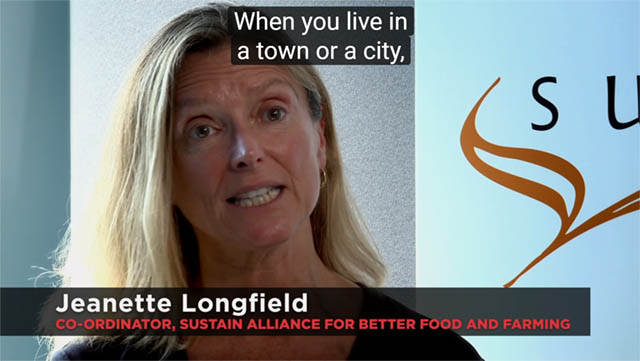 30:06
Jeanette Longfield, co-ordinator, Sustain Alliance for Better Food
and Farming [Sustain advocates food and agriculture policies and practices in UK that enhance the health and welfare of people and animals, improve the working and living environment, promote equity and enrich society and culture.]: When you live in a town or a city, generally speaking,
you don’t grow your own food, and in rich countries, to be
honest, you have to go back generations now to get to anybody in my
family or your family who actually was a farmer. We have literally
lost our roots.
30:06
Jeanette Longfield, co-ordinator, Sustain Alliance for Better Food
and Farming [Sustain advocates food and agriculture policies and practices in UK that enhance the health and welfare of people and animals, improve the working and living environment, promote equity and enrich society and culture.]: When you live in a town or a city, generally speaking,
you don’t grow your own food, and in rich countries, to be
honest, you have to go back generations now to get to anybody in my
family or your family who actually was a farmer. We have literally
lost our roots.
30:24 William Rees: We’ve completely physically displaced people from the ecosystems that support them, and that has been accompanied by a psychological displacement. People no longer have any real sense, that I had as a child, of being part of the planet, of being deeply connected to the Earth.
30:38 Longfield: Once you’ve cut yourself off from the food and farming system you forget how valuable it is, you forget how important it is.
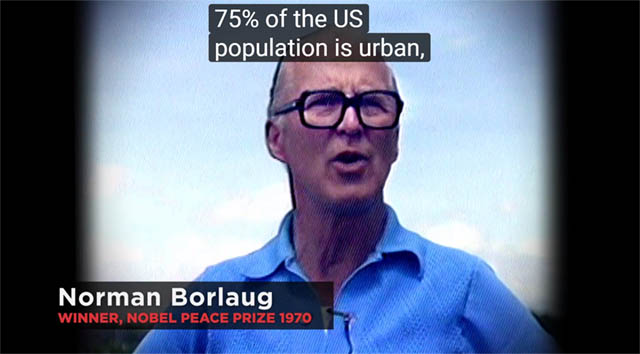
31:15 Sutton: If you have a city that’s this much pavement, inside that city there’s a lot of people doing things that require space outside the city to support their life. This much forest area to absorb the CO2 that’s being emitted, this much crop area to produce the food for all the people that are living in that paved area. This much pavement still requires a massive amount of land outside of it to support the people that are living on the pavement.
32:32 Gary Marcus: It’s always made sense for animals to eat whatever food they could get the minute that they could get it, because they couldn’t plan for the future. Now we have grocery stores that are open 24 hours a day, seven days a week, and we still have that hunger, and we still go ahead and eat far more than we need to because our brains were calibrated to an earlier era where food was not as widely available.
32:54 NARRATOR: So man millions, but only one Earth. Each man’s need is that of his neighbor, for all there is to share is the wealth of the world. The Wealth of the World.
33:12 William Rees: If you take any population, could be an individual population of a city, or a whole country, the ecological footprint is simply a measure of the total area of productive land and water ecosystems needed to produce the resources that that population consumes, and to assimilate the wastes that are associated with that consumption process.
33:33 McKee: If you were to take the entire human population as it exists today, of, well nearly 7 billion people, and spread people out across the land surface area of the Earth evenly, then every individual would have a certain amount of space. That space turns out to be approximately the size of this stadium. That’s the area in which you have to grow your food, put your residence, have your recreational facilities.
33:57 Herman Daly: Economics is about scarcity, so if something is not scarce, it kind of falls out of economics. And so as long as we were living in a basically empty world, that is empty of us, and our stuff, and full of other things, then we could probably get away with just leaving resources out of the picture because they were super abundant.
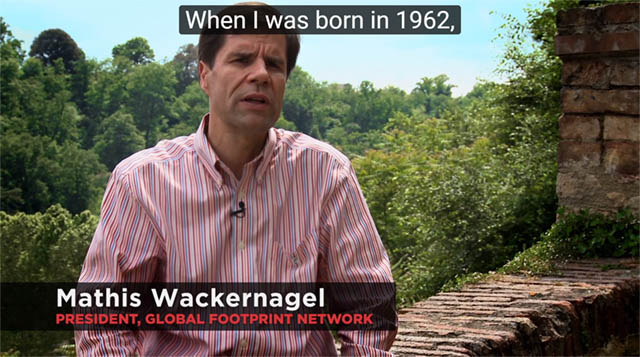 34:22
Mathis Wackernagel, President Global Footprint Network [sustainability advocate. Global Footprint Network, an international sustainability think tank. The think-tank is a non-profit that focuses on developing and promoting metrics for sustainability. After earning a degree in mechanical engineering from the Swiss Federal Institute of Technology, he completed his Ph.D. in community and regional planning at the University of British Columbia in Vancouver, Canada in 1994. There, as his doctoral dissertation under Professor William Rees, he created with Professor Rees the ecological footprint concept and developed the methodology]: When I was
born in 1962, humanity used about half the planet’s capacity.
Today we are using at least 40% more than what Earth can regenerate,
so what humanity uses in one year it takes the biosphere one year and
four to five months to regenerate.
34:22
Mathis Wackernagel, President Global Footprint Network [sustainability advocate. Global Footprint Network, an international sustainability think tank. The think-tank is a non-profit that focuses on developing and promoting metrics for sustainability. After earning a degree in mechanical engineering from the Swiss Federal Institute of Technology, he completed his Ph.D. in community and regional planning at the University of British Columbia in Vancouver, Canada in 1994. There, as his doctoral dissertation under Professor William Rees, he created with Professor Rees the ecological footprint concept and developed the methodology]: When I was
born in 1962, humanity used about half the planet’s capacity.
Today we are using at least 40% more than what Earth can regenerate,
so what humanity uses in one year it takes the biosphere one year and
four to five months to regenerate.
34:41 Herman Daly: What’s the fish catch limited by today? Is it limited by fishing boats and fishermen? No, we’ve got too many fishing boats, more than we need. It’s limited by the remaining fish and their capacity to reproduce. So it’s the natural resource which in the full world has become the limiting factor.
35:01 Joseph Tainter: Someone was talking about conservation there, to which Charlie said, “If you don’t use the oil, someone in China will be happy to use it.” [Charles A.S. Hall? Good guess. I emailed Charlie who replied: "I have said that (classic HT. Odum), and I know Tainter well, so it must be me...."] And he’s right. What's the point of conservation? Unless the whole world signs onto it, what’s the point? China’s not going to sign onto it.
35:25 NARRATOR: And that’s the tragedy of the commons right there. That is a kind of tragedy of the commons, yeah. The Tragedy of the Commons [a 1968 essay by Garrett Hardin, human ecologist]. Imagine a pasture where any shepherd can bring his sheep to graze. The pasture is an open access resource, free for any member of the public to use. One shepherd realizes that if he brings more sheep than anyone else, he can benefit from using more of the pasture at no extra cost [other than as shared by all]. He can bring as many sheep as he likes, whenever he likes, giving him a short-term profit. If he didn’t, somebody else would, right? In the end, the pasture is destroyed by overuse, and everyone suffers the consequences. [And the very clever shepherd, having taken the full range of neo-classical economic classes at Oxford, having full foresight of the consequences, did what he had to do, then invest his profits in BP and then Apple to live in unimaginable luxury until his medical team failed to extend his life any further, despite blood infusions from virgins, though his body was cryogenically frozen.]
36:09 Herman Daly: We have open access resources. They really are scarce.
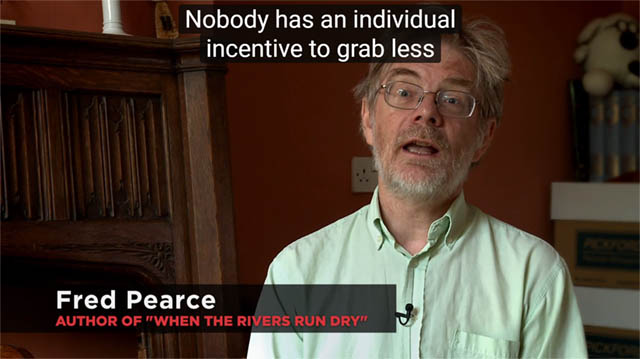 36:14
Fred Pearce, author of “When the Rivers Run Dry” [author and journalist based in London. He is a science writer, reporting on the environment, popular science and development issues from 64 countries over the past 20 years. He specialises in global environmental issues, including water and climate change]: Nobody
has an individual incentive to grab less, because we all share in the
downside in the end, so we kind of rush to disaster.
36:14
Fred Pearce, author of “When the Rivers Run Dry” [author and journalist based in London. He is a science writer, reporting on the environment, popular science and development issues from 64 countries over the past 20 years. He specialises in global environmental issues, including water and climate change]: Nobody
has an individual incentive to grab less, because we all share in the
downside in the end, so we kind of rush to disaster.
36:26 Gleick: The environment, especially, requires government regulation, and government oversight, because without government regulation and government oversight, the environment suffers. And when the environment suffers, the truth is, we all suffer [but only after all, including the homeless living on the street, prosperously consume planetary resources unsustainably].
36:40 Dennis Fox: We already have governments, and things are falling apart. And so, the idea that you have to have government rule in order to keep things from falling apart, I think, historically, it goes the other direction.
36:53 Pearce: Perhaps you have to privatize things in some way if you’re dealing with land, so people can have control over part of this once common resource. The tragedy that Garrett Hardin described didn’t actually happen historically. Those commons were self sustaining, that the people involved did agree among themselves on regulations, and enforce those regulations. And the commons, the commons eventually got destroyed because outside forces came in and took the land away, and that was the end of the commons.
37:21 Greer: Now it has been pointed out, and I think quite rightly, that there are, that traditionally common systems do work because there are social or political controls that keep people from exploiting the commons. But when you get rid of those [controls] as we have in the United States, for example, you end up in a real mess. We are in the tragedy of the commons because we’ve set up an economy whereby all the benefits go to individuals, but all the costs are dumped on society [are commonized. Garrett Hardin regretted not giving his essay the title of “The Tragedy of the Unmanaged Commons”]
37:52 NARRATOR: A land of dark and primitive contrast. Plenty and scarcity. Richness and poverty. Here lived Africa’s peoples, buried in their jungle, too backward to realize the inheritance it offered, the untapped resources of their vast continent. Human need crying in the wilderness. The only answer, the magic of the witch doctor, superstition, age old fears, recurring plague. In Africa, in its jungles, and in its villages, wealth lay wasting [as it had everywhere on the planet before industrial society came to extract it].
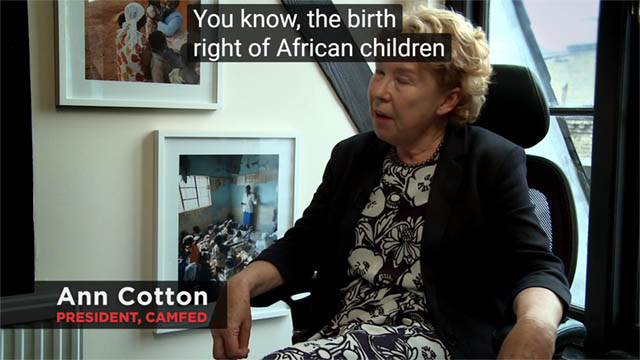 38:37
Ann Cotton, president, Camfed [Campaign for Female Education, is an entrepreneur and philanthropist who was awarded an Order of the British Empire (OBE) in the 2006 Queen's New Year Honours List. The honour was in recognition of her services to education of young women in rural Africa as the founder of Camfed]: You
know, the birth right of African children is being sold. And it’s
being sold internationally. Governments are selling land, and they’re
selling resources. They’re partly, of course, being sold
because they need to invest in their health systems, in their
education systems. So they’re in a kind of viscous cycle.
38:37
Ann Cotton, president, Camfed [Campaign for Female Education, is an entrepreneur and philanthropist who was awarded an Order of the British Empire (OBE) in the 2006 Queen's New Year Honours List. The honour was in recognition of her services to education of young women in rural Africa as the founder of Camfed]: You
know, the birth right of African children is being sold. And it’s
being sold internationally. Governments are selling land, and they’re
selling resources. They’re partly, of course, being sold
because they need to invest in their health systems, in their
education systems. So they’re in a kind of viscous cycle.
38:57 Korten, magazine editor: They’re inviting in those foreign corporations to own and control their resources, and to set their economic priorities. So pretty soon you find that your whole economy is designed and operated, not to meet the needs of your own people [just like all other economies fail to do as that isn’t what economic success selects for].
39:13 Cotton: They’re selling on 99-year leases. Land that has historically provided cattle grazing, land that has historically provided local maize. Land that has given community security.
39:28 Korten: But it is also then the advice that the countries get that say, well, the way to grow your economy and maximize your wealth is to organize your resources for export.
39:41 Longfield: Other people will grow our food for us. We’re so rich we’ll just be able to buy it from them.
39:45 Korten: This new form of colonization, which is very clearly the colonization of essentially everybody, by a small elite class that controls these corporate institutions [that are controlled by the contingencies of short-term profit/benefit as any CEO who fails to deliver the goods is soon replaced].
39:57 Cotton: This is a really rather terrifying fact. And that land is, in many cases, lying fallow.
40:04 Korten: One of the things that just stunned me when I was working in Asia, in development, was to hear economists saying, well, you know, don’t worry about your agricultural sector, that’s, in an advanced country, that’s a very small piece of GDP. Use that land for its higher-value use, like a golf course, or a housing development, or a shopping mall, or an export processing zone, or whatever. But, you know, you’re just wasting it on agriculture. Now they were telling everybody that. So then you ask, well who’s going to grow the food? And it’s, you know, it’s part of this disconnect from reality. Whereas, you say, well, whatever percentage food is of GDP, I still need to eat. [chuckles]
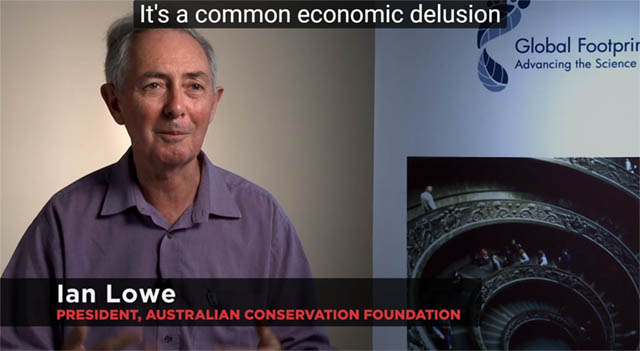 40:57
Ian Lowe, president, Australian Conservation Foundation [authored or co-authored 10 books, 10 Open University books, more than 50 book chapters and over 500 other publications. He wrote for 13 years a regular column for New Scientist and also writes for several other publications, as well as contributing frequently to electronic media programs]: It’s a
common economic delusion that as long as the price is right you will
always get what you need. I think Paul Aleck said that economists
would not worry if they were in a bus going over a cliff because they
would be confident that the sudden market demand for parachutes would
generate a supply before they hit the bottom. Economists simply don’t
believe in limits. They believe that if the price is high enough
there will always be a solution.
40:57
Ian Lowe, president, Australian Conservation Foundation [authored or co-authored 10 books, 10 Open University books, more than 50 book chapters and over 500 other publications. He wrote for 13 years a regular column for New Scientist and also writes for several other publications, as well as contributing frequently to electronic media programs]: It’s a
common economic delusion that as long as the price is right you will
always get what you need. I think Paul Aleck said that economists
would not worry if they were in a bus going over a cliff because they
would be confident that the sudden market demand for parachutes would
generate a supply before they hit the bottom. Economists simply don’t
believe in limits. They believe that if the price is high enough
there will always be a solution.
41:24 Pekny: We can eat down the food chain, but we cannot eat recipes.
41:28 Cotton: We are already short of food, but we will become more and more short of food. So those with the means are buying up, are ensuring against the loss of food.
41:40 NARRATOR: In July 2008, the government of Madagascar agreed to give half of the country’s farmland to a subsidiary of the Daewoo Corporation of South Korea, for free, for 99 years. Daewoo announced plans to export maize and palm oil. A manager at the company said, “Food can be a weapon in this world… We can either export the harvests to other countries, or ship them back to Korea in case of a food crisis.” In March, 2009, the government of Madagascar was overthrown by a coup d’etat and replaced. The new government canceled the deal saying that it was in violation of Madagascar’s constitution. In response, Madagascar was suspended from the African Union, and had foreign aid withheld by the World Bank for over two years.
42:26 Duncan Pollard, Director of Conservation Practice & Policy WWF International: If everyone was to aspire to a western-style diet, and the average western-style diet is an Italian diet, both in terms of the number calories, and the amount of meat that’s consumed, there isn’t enough land on the planet to feed everybody. Whether that’s 8 billion, or 9 billion, or 10 billion. It doesn’t matter, there isn’t enough land.
42:45 Pearce: You know, there are people arguing that there is enough food to go around in the world, the problem is the way it’s distributed. And I forget the ratio, but how many people you could feed with the grain that goes into making one Big Mac, but it’s a lot of people.
42:58 Lowe: The world now produces about two kilograms of food, per person, per day. So if it was shared equally each person would have each day about a kilogram of fruit and vegetables, about half a kilogram of cereals and pulses, and about half a kilogram of protein, in the form of meat or fish, or eggs. Now, it would take a pretty good trencherman to get their jaws around two kilograms of food a day. And even in the rich parts of the world people don’t consume at that level.
43:28 Longfield: The reason why people starve in a country, in a world that has enough food, is because they don’t have the money or the power to buy it.
43:37 Pearce: We have a globe where some parties have much more power than others, and some parties have much more power to regulate, and to determine the rules that they want others to live by.
43:48 Lowe: If we distribute food through a market it means that dogs and cats in the United States of America eat better than peasants in poor parts of the world.
43:56 Longfield: It’s not about the food in the long term, it’s about money, and it’s about power. No rich person ever starved. [Food is about energy, the only energy humans needed in the environment they evolved in. Money follows energy flows in reverse direction. Energy is the precondition for and basis of real wealth. Money was unknown to pre-anthropocene enthusiasts. No poor person ever died of over-consumption, so embrace a voluntary poverty of just enough.]
44:04 NARRATOR: The use of resources became unequal. Although each living unit was identical in structure and opportunities, more food and water was consumed in some areas. In 2011, 20% of the world’s people consumed 80% of the world’s resources, leaving 20% of the world’s resources for 80% of the world’s people. [as measured by money that the upper 20% have virtually all of].
44:27 William Rees: One thing that differentiates us from Calhoun’s experiments as I recall them is that there was never a resource scarcity.
44:36 NARRATOR: In 1970, a scientist named Norman Borlaug won the Nobel Peace Prize for his ongoing work to increase food production around the world. Using pioneering techniques of genetic modification, Borlaug designed strains of wheat, corn, and rice, which fed over a billion people worldwide. The Green Revolution, as it was called, is hailed even today as the triumph of man over the limits of nature. Worldwide, we’ve doubled the amount of crops that we grow over the last 40 years. We needed to, because world population doubled. But we are taking three times more water out of our rivers to do it.
45:14 Gleick: Water’s basically a renewable resource. The river flow we see today, no matter how much we use today, is going to come back in rainfall tomorrow, and we’re going to get more river flow. But there are peak limits to even a renewable resource. We can’t use more water than a river naturally provides.
45:32 Pearce: Now you may think about how much you drink, or how much water you use to flush the toilet, but the real demands on water around the world for you to get through your day are food and drink, and perhaps for growing cotton for your clothing. I worked out my water footprint. It is 100 times my own weight in water every day. That’s what’s needed to get me through my life. And you imagine that among 7 billion people. That’s a huge demand on nature’s water cycle.
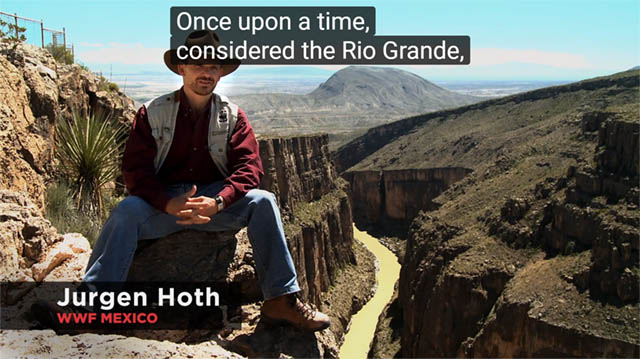 46:36
Jurgen Hoth, WWF Mexico [working on soil and water conservation in natural areas from central Mexico]: Once upon a time, considered the Rio Grande,
or Rio Bravo, which means brave, means violent, and nowadays it’s
tame and it’s small.
46:36
Jurgen Hoth, WWF Mexico [working on soil and water conservation in natural areas from central Mexico]: Once upon a time, considered the Rio Grande,
or Rio Bravo, which means brave, means violent, and nowadays it’s
tame and it’s small.
48:49 Pearce: Northern China, the Yellow River doesn’t reach the sea in anything other than tiny amounts. Central Asia, running out of water.
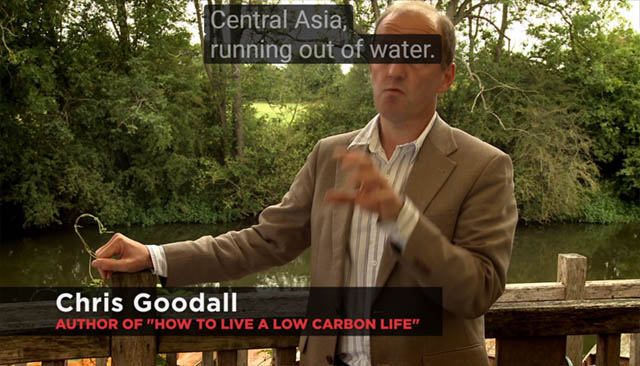 46:54
Chris Goodall, author of “How to Live a Low Carbon Life” [English businessman, author on new energy technologies]:
The Aral sea will dry up. The Nile no longer reaches the
Mediterranean Sea. The Colorado, like the Nile, like the Yellow, no
longer reaches the mouth.
46:54
Chris Goodall, author of “How to Live a Low Carbon Life” [English businessman, author on new energy technologies]:
The Aral sea will dry up. The Nile no longer reaches the
Mediterranean Sea. The Colorado, like the Nile, like the Yellow, no
longer reaches the mouth.
47:06 Pearce: You go to Pakistan, the river Indus, another great river, being completely dried up for much of the year because all the water is being taken out to grow crops.
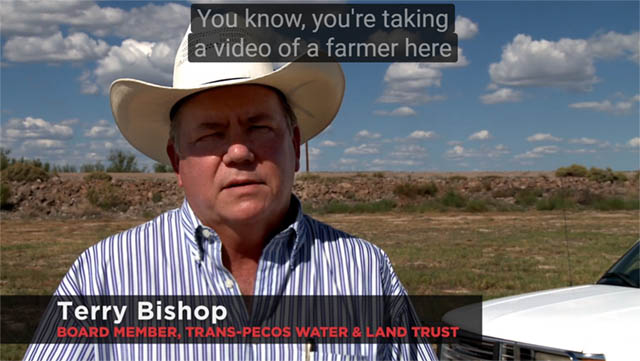 47:16
Terry Bishop, board member, Trans-Pecos Water & Land Trust: You
know, you’re taking a video of a farmer here who basically
lost his way of life due to lack of, not only water quality, but
quantity. They’re now pumping water underground so much that it
is getting contaminated.
47:16
Terry Bishop, board member, Trans-Pecos Water & Land Trust: You
know, you’re taking a video of a farmer here who basically
lost his way of life due to lack of, not only water quality, but
quantity. They’re now pumping water underground so much that it
is getting contaminated.
47:33 Pearce: The water table is going down. The Gaze has stripped right next to the Mediterranean Sea. The underground rocks where the water is held are being invaded by salty seawater.
47:45 Bishop: What there is that you can draw is such a poor quality, it’s just salty. It’s kind of like sprinkling salt on your ground. So every time you water you’re making your land worse.
47:57 Pearce: So the only water resource that the people, the Palestinian people of Gaza have, to fill their taps, to grow their crops, is a water resource which is becoming, year by year, more and more salty, more and more saline. At some point, and not far away, that will be too salty to grow crops. The salt will simply kill the crops. It will be too salty to drink. What does Gaza do then?
48:26 Peter Gleick, author of “Bottled and Sold”: When you are using a non-renewable water resource, like a groundwater aquifer, that’s recharged very slowly, it’s exactly like peak oil. You have peak water limits when you over pump groundwater aquifers.
48:39 Lowe: In the mid 1950s M. King Hubbert predicted that US oil production would peak about 1971, and that the US would subsequently become a major purchaser, which could lead to an international oil crisis by changing the balance between producers and consumers.
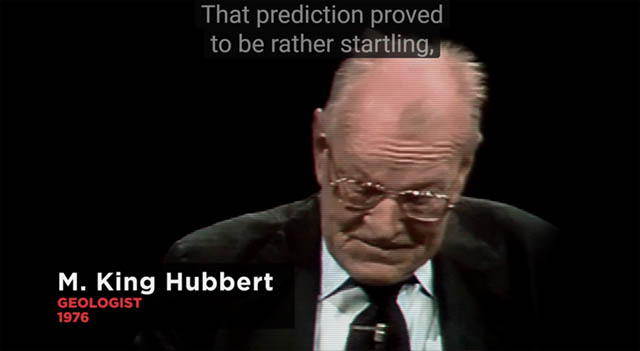 48:55
M. King Hubbert, geologist [and geophysicist. Instigator of revived Technocracy Inc. 1932. He made several important contributions to geology, geophysics, and petroleum geology, most notably the Hubbert curve and Hubbert peak theory (a basic component of peak oil), with important political ramifications]: That prediction proved to be rather
startling, and somewhat distressing. This is as of 1972. So this
curve is going on up, now that little peak there is the year 1970,
and we’re down in 1971....
And we’ve been going down about 5% per year even since.
48:55
M. King Hubbert, geologist [and geophysicist. Instigator of revived Technocracy Inc. 1932. He made several important contributions to geology, geophysics, and petroleum geology, most notably the Hubbert curve and Hubbert peak theory (a basic component of peak oil), with important political ramifications]: That prediction proved to be rather
startling, and somewhat distressing. This is as of 1972. So this
curve is going on up, now that little peak there is the year 1970,
and we’re down in 1971....
And we’ve been going down about 5% per year even since.
49:15 Lowe: The US started to become a major purchaser, the balance between producers and consumers changed. The OPEC oil crisis happened in 1973. The price of oil went from $1.90 a barrel to $30 a barrel in eight years, and the world as we know it changed.
49:31 Hubbert: Now, to this complete cycle for the world, to give you a time scale on that, bear in mind that started in 1857. And so here’s where we were about three or four years ago. This was proved reserves in here, which would add up to about here, and the estimated peak occurs about 1995, and we go into the decline.
49:51 Greer: Our civilization has been built around the idea that there’s always going to be more energy available next year than this year. And it’s been true, you know, we’ve always been producing more coal, then producing more oil, producing more everything.
50:02 Rapier: The nature of the problem’s not that we’re running out of oil, the nature of the problem is that we have expanded the economy on growing oil production for 100 years now, and the population has exploded with the growth in oil production.
50:16 Greer: So you have a gradually declining production of oil, while you have constantly increasing demand, and the gap that opens between there becomes a chasm into which the economy falls.
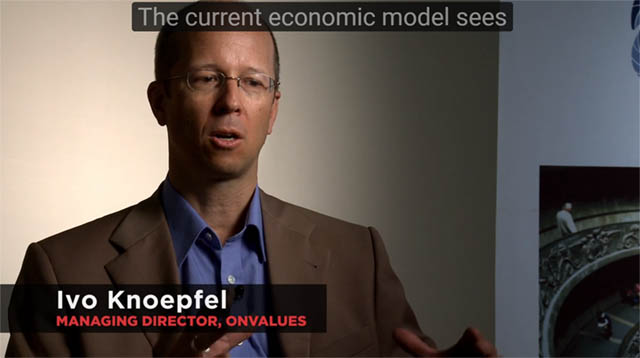 50:28
Ivo Knoepfel, managing director, Onvalues [contributed his entire professional life to integrating the concept of sustainability into the worlds of business and finance]: The current economic model
sees growing populations often as a positive, and doesn’t
factor in the fact that growing population is increasingly clashing
against the ecological limits.
50:28
Ivo Knoepfel, managing director, Onvalues [contributed his entire professional life to integrating the concept of sustainability into the worlds of business and finance]: The current economic model
sees growing populations often as a positive, and doesn’t
factor in the fact that growing population is increasingly clashing
against the ecological limits.
50:44 Joseph Tainter: Usually we value things in terms of money, but in fact the ultimate value is energy, because energy is the source of money.
INTERVIEWER: We shovel coal for 10 hours, we get a paycheck, we go and eat a meal. But instead, what we do is, we eat the meal first, and then there’s a backlog of coal that we have to shovel. And all that’s happening is we’re backing it up to the point where there aren’t years in the human lifespan to work for long enough to pay off the debt we’ve accumulated to the things that we’re taking.
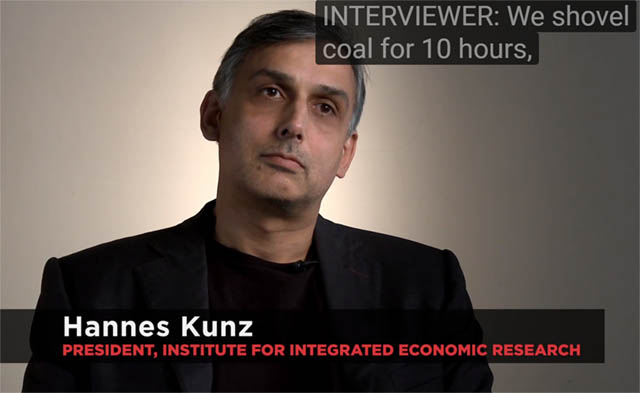 51:12
Hannes Kunz, President, Institute of Integrated Economic Research:
Yes, there’s not enough coal to shovel, or not enough hours to
shovel the coal. Depends on how you want to look at it.
51:12
Hannes Kunz, President, Institute of Integrated Economic Research:
Yes, there’s not enough coal to shovel, or not enough hours to
shovel the coal. Depends on how you want to look at it.
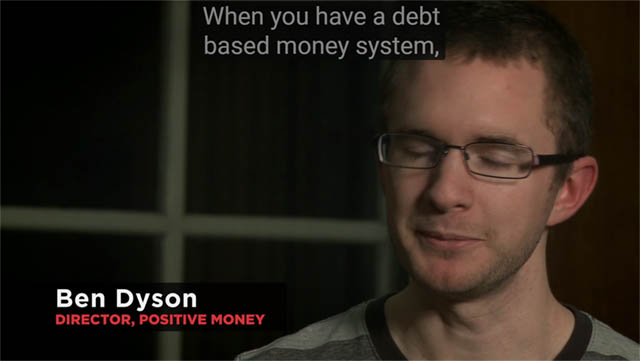 51:18
Ben Dyson, director, Positive Money [research focuses on potential reforms to monetary policy, structural reforms to the banking system, and the potential for technology to disrupt the payment and banking systems]: When you have a debt based money
system, as we do now, it basically drives economic growth. Not in a
good way, in quite a destructive way. In the simplest sense the
system guarantees that in order for there to be money in the economy
for the economy to function, we have to have the debt as well.
51:18
Ben Dyson, director, Positive Money [research focuses on potential reforms to monetary policy, structural reforms to the banking system, and the potential for technology to disrupt the payment and banking systems]: When you have a debt based money
system, as we do now, it basically drives economic growth. Not in a
good way, in quite a destructive way. In the simplest sense the
system guarantees that in order for there to be money in the economy
for the economy to function, we have to have the debt as well.
51:35 Kunz: My assumption is that this is no longer possible given the complexity of getting at resources, as I said, and the complexity at serving debt, and therefore also creating more debt which will be hampered by the risk that is inherent to new debt because it’s just on top of a lot of other existing debt.
51:51 Dyson: So, in terms of how money is created, on the simplest level, the numbers in your bank account are not actually money. It’s effectively a representation of what the bank promises to pay you at some point in the future. So because this isn’t actually money and it’s in a digital form, there is no law that makes it illegal for banks to create this type of money. So the numbers in your account could actually be created by a bank just at their own choice. And when the bank makes a loan, these numbers are created out of nothing. So where we are now, effectively every single pound in your own bank account, and everybody else’s bank account was created by commercial banks, effectively out of nothing, at the point when they make a loan. So in other words, all money is debt.
53:11 “The greatest shortcoming of the human race is our inability to understand the exponential function.” --Albert Bartlett
53:17 Kunz: We’ve now built this system that has almost everything we do built with money we have to pay back, so work we have to do in the future, resources we have to use in the future.
53:30 Dyson: One of the most recent figures is 2,700 billion of debt, and only 2,200 billion of money. So we’re already past the point where we could repay the debt. If we took all our money now, used it to pay off the debt, then we’d be left with absolutely no money, and yet we’d still owe around 500 billion to the banks.
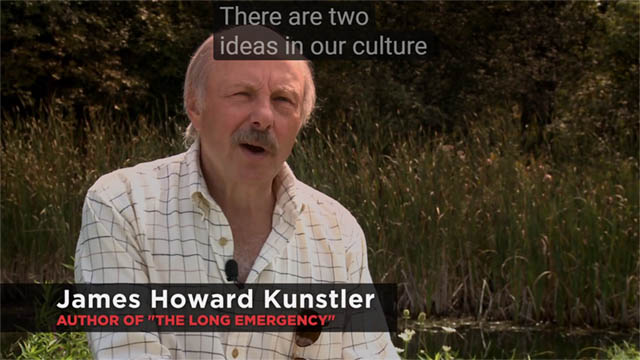 53:47
James Howard Kunstler, author of “The Long Emergency” [author, social critic, public speaker, and blogger]:
There are two ideas in our culture that have kind of captured the
public imagination in the last 30 years that are very dangerous. One
is the idea that if you wish upon a star your dreams will come true.
It’s a good idea for seven year olds, you know, it helps them
sleep, but it’s not good for fully functioning adults who need
to know the difference between wishing for stuff and making stuff
happen. And the companion idea to that is the idea that it’s
possible to get something for nothing. You know, and that’s why
Las Vegas is so popular, because now everybody wants to believe you
can get something for nothing. Well, you know, that really doesn’t
comport with the way reality works. And unfortunately you combine
these two ideas, that when you wish upon a star you’ll get
something for nothing, that’s sort of where we’re at.
53:47
James Howard Kunstler, author of “The Long Emergency” [author, social critic, public speaker, and blogger]:
There are two ideas in our culture that have kind of captured the
public imagination in the last 30 years that are very dangerous. One
is the idea that if you wish upon a star your dreams will come true.
It’s a good idea for seven year olds, you know, it helps them
sleep, but it’s not good for fully functioning adults who need
to know the difference between wishing for stuff and making stuff
happen. And the companion idea to that is the idea that it’s
possible to get something for nothing. You know, and that’s why
Las Vegas is so popular, because now everybody wants to believe you
can get something for nothing. Well, you know, that really doesn’t
comport with the way reality works. And unfortunately you combine
these two ideas, that when you wish upon a star you’ll get
something for nothing, that’s sort of where we’re at.
54:31 NARRATOR: Dr. Calhoun explains what the overcrowding did to Mouse City’s inhabitants.
54:37 Calhoun: The last thousand animals born never learned to develop the social behaviors. They never learned to be aggressive, which is necessary in the defense of home sites, not engaging in any stressful activity, and only paying attention to themselves. They groomed themselves well so they looked very fine specimens, so they looked very fine specimens.
54:58 NARRATOR: Dr. Calhoun called these individuals the beautiful ones. Their time was devoted solely to grooming, eating, and sleeping. They never involved themselves with others, engaged in sex, nor would they fight. All appeared as a beautiful exhibit of the species with keen, alert eyes, and a healthy, well-kept body. These mice however could not cope with unusual stimuli. Though they looked inquisitive, they were in fact very stupid.
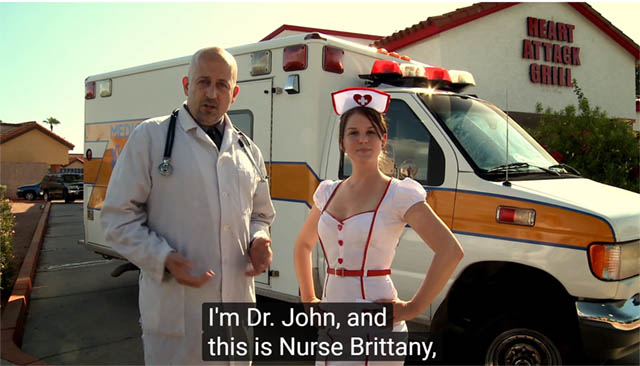 55:54
Jon Basso, owner, The Heart Attack Grill: The North American landmass is actually sinking. And they attribute this to the burgeoning
waistlines in the United States. Now, whether or not that’s
true, I don’t know, but I did read this in the American
National Enquirer.
55:54
Jon Basso, owner, The Heart Attack Grill: The North American landmass is actually sinking. And they attribute this to the burgeoning
waistlines in the United States. Now, whether or not that’s
true, I don’t know, but I did read this in the American
National Enquirer.
56:09 Battle of Ideas, London, October 2010: The main Malthusian idea I want to challenge today is the idea that resources are finite.
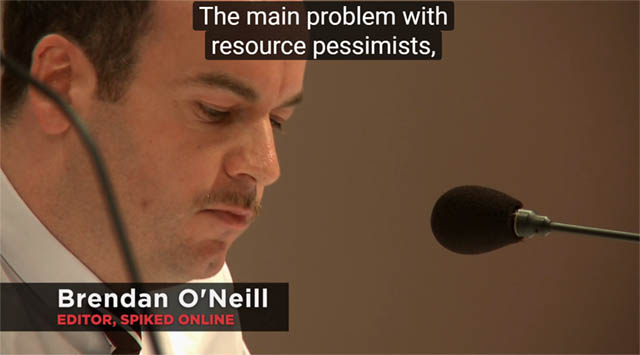 Brendan
O’Neill, editor, Spiked Online [He began his career at Spiked's predecessor, Living Marxism, the journal of the Revolutionary Communist Party, which ceased publication after ITN won their libel action against it. Since then, O'Neill has contributed articles to publications in the United Kingdom, the United States and Australia including The Spectator, the New Statesman, BBC News Online, The Christian Science Monitor, The American Conservative, Salon, Rising East and occasionally blog]: The main problem with resource
pessimists, such as Malthusians, is that they continually mistake
social limits for physical limits. The space issue is just a complete
red herring. I mean, go to somewhere like Australia, there’s no
one there. You could have billions and billions of people in
Australia alone, so the space thing just doesn’t work.
Brendan
O’Neill, editor, Spiked Online [He began his career at Spiked's predecessor, Living Marxism, the journal of the Revolutionary Communist Party, which ceased publication after ITN won their libel action against it. Since then, O'Neill has contributed articles to publications in the United Kingdom, the United States and Australia including The Spectator, the New Statesman, BBC News Online, The Christian Science Monitor, The American Conservative, Salon, Rising East and occasionally blog]: The main problem with resource
pessimists, such as Malthusians, is that they continually mistake
social limits for physical limits. The space issue is just a complete
red herring. I mean, go to somewhere like Australia, there’s no
one there. You could have billions and billions of people in
Australia alone, so the space thing just doesn’t work.
56:23 Roger Martin, chairman, Population Matters: [Listening]
56:34 Basso: We tell people live for the day. In fact, that day might not even be very long.
56:41 NARRATOR: Dr. Calhoun called the last period the die phase, leading to population extinction. Although the mouse utopia could house 3,000 [3,840], the population began to decline at 2,200.
For animals up to a year of age, who’ve come up in the latter history of the colonies, there’s essentially no evidence of conceiving. So there is, at this stage, this is part of the overliving phenomenon. And it's these individuals who are not conceiving, are the ones which are not stressed. They’re the beautiful ones who lack involvement. They’ve never learned to court, there was no mating. Being no mating there were no progeny, and the older animals, whose behavior was already becoming disrupted, they eventually reached an age too old to reproduce. Reproduction totally ceased, and the animals have just aged and died.
57:43 Adams: Calhoun repeats this experiment several times, and each time the same range of behavioral pathologies are exhibited, they’re reliably exhibited. The population begins to die off, and does so inexorably. It dies off to extinction each time.
57:57 NARRATOR: Eventually, the entire mouse population perished. Dr. Calhoun’s experiment is a classic example of a typical population, and its growth when left unchecked.
58:10 William Rees: And so, in effect, by providing absolute abundance of all necessities, the base requirements of existence, these populations bred themselves to a point where behavioral change was so endemic that the populations crashed to extinction.
58:27 Greer: I see population not so much as driver, but as a natural follow through from the age of cheap energy. This 300 year period when we have been using up half a billion years of stored sunlight to give ourselves more energy than any other group of human beings has ever had in history.
58:44 Joseph Tainter: Everything that we do in our society comes from energy. Our wealth comes from energy, our ability to innovate comes from energy. Our ability to progress comes from energy, and specifically from fossil fuels.
58:57 James Howard Kunstler: There’s nothing abstract about it. The way we do food production, you know, agriculture, farming, the way we do commerce, retail, buying and selling things, the way we do manufacturing, the way we inhabit the landscape, the way we do transportation around the landscape. You know, these are the complex systems that we depend on for everyday life. And as we go down the arc of oil depletion, these systems are going to not only destabilize, but reinforce each other’s instabilities.
59:33 Marcus: If you look around you, everything that you see was either brought there by oil or is made out of oil. The things we eat are made out of oil, because pesticides that are made from oil, herbicides that are made from oil, and natural gas that makes the fertilizer, and the oil that makes the tractors run, and the trucks run. The last 100 years of oil production is what enabled the population explosion, and when oil declines, the population must decline.
1:00:00 Colin Campbell: By 2050, the supply of oil will have fallen to support no more than half the present world population in their present way of life. I stress present way of life.
1:00:13 M. King Hubbert: If we, for example, ran out of energy, or went into a technological decline, we’d be back down to a low energy level. Then we’d have to drop the population back to a level that could subsist like that.
1:00:25 Kunstler: We’re simply going to have to move, blunder our way forward to a period of time when there are fewer people on the planet, and in the meantime there are going to be too many for a while.
1:00:37 Greer: We’ve had a big population bubble, on top of all the other bubbles we’ve been blowing. Is it a problem, yes. Will it solve itself? I’m sorry to say, yes it will. There are four very familiar cures for overpopulation, and they ride horses.
1:00:54 William Rees: Tensions are inevitably going to increase as expectations are not satisfied, and as countries find it increasingly difficult to supply even the basics of life. We saw a marked example of that in 2008 when global food prices spiked with the increase in oil prices.
1:01:13 Kunstler: So much damage has been done to the ecosystem itself that I doubt that everybody’s going to be happy. I doubt that everybody’s going to be fed, even as consumption levels fall in the most advanced societies.
1:01:29 Colin Campbell: If they can figure out how to live differently you can support more people, but if you don’t figure out how to adapt to this reduction in the critical oil supply, which drives more or less everything, well, the only conclusion from that is fewer people.
1:01:45 Rapier: You talk to the average person and they’ll say, oh yeah, there’s solutions. There’s algae, and there’s cellulose, and all these things can replace oil, when really they can’t. In theory, maybe someday solar can, but biomass never will, other than a small contribution.
1:02:02 Greer: The 5% of people, of the human race that lives in the United States, uses 25% of the world’s oil, and about 33% of the world’s other natural resources and industrial product. That doesn’t happen because the rest of the world doesn’t want it, okay. That happens because we take it. That happens because we are the imperial power right now, as Britain was 100 years ago, as Spain was 200 years before that, and so on.
1:02:25 Colin Campbell: I don’t know whether perhaps you should switch off your machine briefly. [chuckles] Did I tell you when the CIA came here, did you know that?
INTERVIEWER: No.
Oh, well, it’s a funny thing. I had a call from the US Office of Naval Intelligence, London office, and a man said we’re having an important conference in Washington with the military and so on, and we would like you to go and make a peak oil presentation.
1:02:56 Rapier: The American military is out right now asking for alternatives. They want to know how they’re going to fuel their jets in the future, and there was a recent report came out that they forecast that there could be a 10 million barrel a day shortfall by 2015 [delayed by fracking]. That was a report from the US military, and the problem with that kind of shortfall is the militaries cannot run unless they have substantial supplies of oil. The US military is the largest consumer of fossil fuels in the world, and if they don’t get those fossil fuels they’ll come grinding to a halt, unless they go out and secure them.
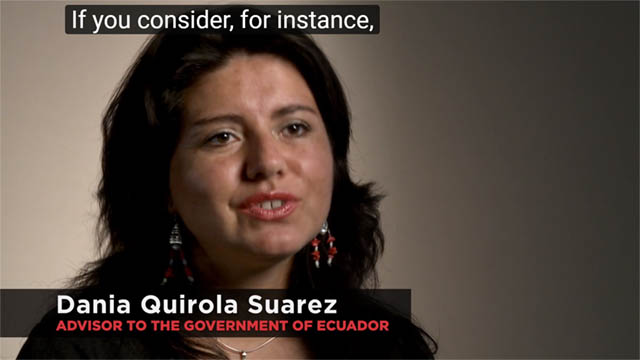 1:03:30
Dania Quirola Suarez, advisor to the government of Ecuador: If you
consider, for instance, the map of Latin America, and identify where
these sources are located in terms of minerals, in terms of oil, or
gas, and you cross map with [where] military stations of some
countries, from other areas which are not from Latin America, are
located, or were located, you’ll see that there’s a
match.
1:03:30
Dania Quirola Suarez, advisor to the government of Ecuador: If you
consider, for instance, the map of Latin America, and identify where
these sources are located in terms of minerals, in terms of oil, or
gas, and you cross map with [where] military stations of some
countries, from other areas which are not from Latin America, are
located, or were located, you’ll see that there’s a
match.
1:03:55 Lowe: How concerned do you think Americans would be about human rights in Iraq if it had 10% of the world’s broccoli?
1:04:01 Greer: This is what I mean about America being an imaginary country because people don’t think they live in that kind of a country. They don’t think they live in a country where the oil in their gas tanks is being bought by blood. Now that’s the world we actually live in, but people don’t see it that way. That’s a foreign thought to them.
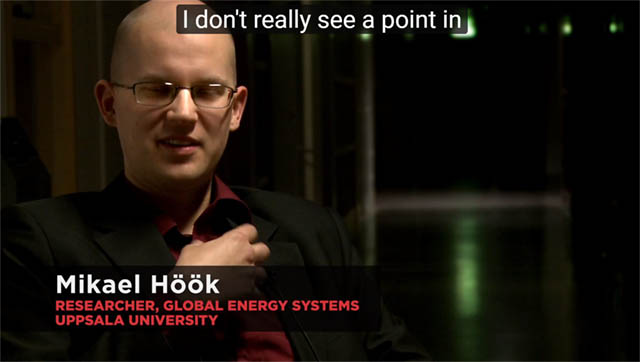 1:04:22
Mikael Höök, researcher, Global Energy Systems, Uppsala
University [senior lecturer and heads the Global Energy Systems Research group. Research deals with availability and production of fossil fuels with focus on oil and coal, but also supply of other natural resouces such as uranium, lithium and raw materials for clean/green energy technologies. In addition, studies energy systems developments, sustainability and energy security]: I don’t really see a point in getting and craving
more and more things all the time without ever being satisfied. It
just gives me this impression that that is the will of some kind of
hollow, empty creature that just has this infinite hole in its heart
[T.S. Eliot, The Hollow Men, e.g. Kurtz and all other SYSTEM servers
who sell themselves]. It just demands more, and more, and more,
trying to fill this unfillable void.
1:04:22
Mikael Höök, researcher, Global Energy Systems, Uppsala
University [senior lecturer and heads the Global Energy Systems Research group. Research deals with availability and production of fossil fuels with focus on oil and coal, but also supply of other natural resouces such as uranium, lithium and raw materials for clean/green energy technologies. In addition, studies energy systems developments, sustainability and energy security]: I don’t really see a point in getting and craving
more and more things all the time without ever being satisfied. It
just gives me this impression that that is the will of some kind of
hollow, empty creature that just has this infinite hole in its heart
[T.S. Eliot, The Hollow Men, e.g. Kurtz and all other SYSTEM servers
who sell themselves]. It just demands more, and more, and more,
trying to fill this unfillable void.
1:04:46 Basso: I’m Dr. John, and this is Nurse Brittany, and we’d like to welcome you to the Heart Attack Grill, the home of the quadruple bypass. After the various layers of cheese, and onions, and tomatoes, and American beef, and the entire thing is lard dipped, is a solid two pounds of meat.
1:05:05 NARRATOR: There is a creature that has to feed. It stops at nothing to fill its need.
1:05:18 Basso: Now, if you’re over 350 pounds, you’re going to love it because we’ve got a special surprise for anyone like that.
1:05:32 NARRATOR: The creature tells of evil gnomes coming to destroy our homes. [music lyrics: Provided with so much distraction The people can’t be moved to action And when the people are all dead A parasite cannot survive Unless its host remains alive It has amassed such awesome wealth Maybe it can eat itself.]
1:06:47 NARRATOR: One of the most unusual examples of changing balance in a natural community occurs in Scandinavia. Here is a species of rodents called Lemmings inhabits the bleak Tundra. A lemming is a small animal that reproduces very quickly. Lemmings breed from spring to fall, and in favorable years, even in winter.
1:07:12 Desmond Morris: Lemmings have a very strange population control system, a bit like, I hope not like ours. But what happens to lemmings is that they breed, and they breed, and they keep going nicely, and then they have a lemming year. And in a lemming year, it only happens so often, but when a lemming year comes it’s just an accident of the food supply. And suddenly they overpopulate to a point where in the wild they’re just like Calhoun’s rats were in his experiment where he overcrowded them.
1:07:43 NARRATOR: As more and more individuals are born the food and water supply begins to diminish. Every three to four years the populations in some localities grow to great densities. And then something amazing starts to happen.
1:08:03 : The myth of them jumping over a cliff, of course, is simply a symbolic way of describing it, but what happens if you look at these lemmings, as I have, is that they become completely stressed out of their minds. They’re dashing here and there, they don’t know what they’re doing, they succumb to disease. The whole society breaks down because they’ve been too successful.
1:08:23 NARRATOR: Individuals begin to migrate away from centers of dense population. They group together and move in detectable waves across the countryside. Wherever barriers block their passage they tend to crowd in rising numbers until a kind of panic reaction drives them over the obstacle.
1:08:45 : I actually imported some, in a lemming year, to study them, and they were animals in total disharmony, is the only word I can use. I’d studied lots of species of rodents and when I saw these lemmings in a lemming year it was like looking at an animal in crisis. It’s movements, it’s behavior, everything about it was agitated, distressed. And what had happened was that the over population that had destroyed the society had increased the level of stress of a kind that you see in a suicide in the slums of the city. And that’s what I was seeing in these lemmings.
1:09:28 NARRATOR: Once again they begin swimming. They act under the same impulse that forced them to cross smaller bodies of water. Swimming until exhausted, all of them drown.
1:09:41 : They can’t take the stress the way that humans are able to. We’re brilliant at taking stress. They can’t take it and their whole society collapses, and then they go back to the old level again.
 1:09:52
NARRATOR: Something in the environment stimulates this activity. If
we were to plot the growth and decline in population of the lemmings,
we would see that as several years go by the population growth the
population growth curve would look lie this with a rapid drop-off
occurring around the fourth year. This growth curve is a classic
example of a population cycle in the ever-fluctuating balance of
nature.
1:09:52
NARRATOR: Something in the environment stimulates this activity. If
we were to plot the growth and decline in population of the lemmings,
we would see that as several years go by the population growth the
population growth curve would look lie this with a rapid drop-off
occurring around the fourth year. This growth curve is a classic
example of a population cycle in the ever-fluctuating balance of
nature.
1:10:21 : The problem for human beings is that if we’re not careful, we’ll have a lemming year.
1:10:26 Gary Marcus: By and large, the tendency for the entire species is to really be focused on the short term problems. So people, for example, think about the eventual oil shortage. We don’t know exactly when it’s going to happen, but it's clear that oil is a finite resource, and lots of people are worried about that. But at the end of the day they still might get into their SUVs, or they might drive back and forth to their country houses, if they have one, or whatever. And so people can have these long term views, but then the short-term decision is what should I do this weekend? And what could I do this weekend, well it would be fun to get into the SUV and drive off to the mountains.
1:11:01 Greer: In the very late 1970s, very early 1980s, everyone [maybe everyone he knew] assumed that the energy crisis was just going to keep on going. That we had entered the age of scarcity, that it was going to be solar energy, and you know, economic contraction, and getting by with less, from then on. Everybody [that I knew] was blindsided by what actually happened because nobody thought that the governments of the industrial world would be stupid enough to take the last big stocks of petroleum they had. The north slope of Alaska, the North Sea, and pump them like there was no tomorrow. That’s what happened. That’s what ended the energy crisis of the 1970s. They basically turn on the stops, pumped them dry to get a couple of decades of, you know, political success. To basically make everybody happy for that short term. By doing so they flushed our chance of having any kind of less than traumatic transition. [And with peak oil “everyone” thinks industrial society will collapse, but maybe we’ll dig coal like there is no tomorrow to enable a slower fall.]
1:12:05 Ian Lowe: I gave public lectures in the 1970s and printed papers saying the best estimate of when world oil production would peak was about 2010, plus or minus 10 years [before fracking]. I remember saying that fortunately that gave us 30 or 40 years to plan a smooth transition out of the age of cheap and unlimited oil towards an age where oil would be limited and more expensive. I’ve got a concise summary here of how we’ve used the 40 years to prepare for the age of limited and expensive oil.
1:12:34 NARRATOR: Perhaps the most chilling conclusion from his Mouse City studies, says Dr. Calhoun, is that once this change in social behavior occurs it apparently cannot be reversed.
1:12:46 Calhoun: It is this fact of apparent irreversible phase shift that gives some of us a particular concern over the fate of the human situation.
1:12:54 Adams: A state change happens. Calhoun calls this a behavioral sink. Even if you take one of those rats out and put it into a more benign environment it never exhibits normal behavior again.
1:13:07 Chris Goodall: Almost all physical environmental systems have that kind of tipping point. The point where what had been quite stable suddenly changes state dramatically.
1:13:17 William Rees: There seems to be something about the human species, a natural predisposition to continue to expand. A natural tendency to discount the future, not to pay much attention to warnings that things are going awry.
1:13:32 Goodall: The most obvious examples are the destruction of human societies like Easter Island, where they must have been aware that things were going downhill very rapidly in the last century of humankind’s existence on the island, but they didn’t do anything about it [although Muzuki tried]. And the same thing appears to be happening here.
1:13:47 Greer: If industrial civilization is on its downslope then everything that most people in the industrial world have staked their future on is dust in the wind. Everything that they’ve hoped, everything they’ve dreamed for, everything they’ve planned for. Their retirement is gone, their investments will be worthless. Their goals for the future, their hopes for their children, you know, are dust and ashes.
1:14:13 James Howard Kunstler: The situation we face is pretty sad, and we kind of blew it [“we” were never in control]. You know it seems to be in the nature of human beings to carry everything a bit too far. And then to have to reset the operations of daily life.
1:14:36 Greer: We’re talking about the death of a civilization. We’re talking about the death of a dream, of a vision of human possibility. Of what human beings are, what they can hope for. And we’re talking about the death of a lot of hopes, and a lot of plans. A lot of securities, well, both in the financial sense, and more broadly, a lot of people.
1:14:59 Adams: Even, I think, towards the end of his life, Calhoun was concerned that was the direction we were heading in. And I think, having seen how his rats behaved, he was concerned that similar things may happen to us.
1:15:13 Calhoun: We see, worldwide, the breaking down of social roles. The increase in contact, both a result of the breakdown of social roles, and because there are too many people, that this might lead to an overriding of our controls of our total culture, and we’d be set into a process which would either fix us rigidly forever into some sort of global tribalism, without any adaptation to change, or it would result, perhaps, eventually some decline, very much like we’ve seen here. [Lyrics to This Would be Paradise: Man is now able to fly through the Air like a bird, He’s able to swim beneath The sea like a fish, He’s able to burrow beneath The ground like a mole. Now if only he could Walk the Earth like a man This would be paradise. Man is now able to fly Through the air like a bird, He’s able to swim beneath The sea like a fish, He’s able to burrow beneath The ground like a mole. Now if only he could walk The Earth like a man, This would be paradise. Now if only he could walk the Earth like a man.]
1:17:41 Adams: There was no way that the stresses that constant interaction placed on people, and on rats, were sustainable. But it was also the case that you were stuck with this situation. How do you get yourself out of it?
 1:17:54
Calhoun: We like to say we are revolutionists here, but a particular
kind of revolutionists which you could now spell differently. Now,
you well know what this symbol is, this is prescription, but…
So, we’re concerned with a prescription for evolution, of the
design of the future, the design of evolution. So we’re
revolutionists.
1:17:54
Calhoun: We like to say we are revolutionists here, but a particular
kind of revolutionists which you could now spell differently. Now,
you well know what this symbol is, this is prescription, but…
So, we’re concerned with a prescription for evolution, of the
design of the future, the design of evolution. So we’re
revolutionists.
1:18:20 Adams: It’s easy to look at Calhoun’s work and simply see him as a kind of demon of rodents. As someone who is just out there to make their lives bad. That he’s some kind of rodent sadist. Calhoun wasn’t simply interested in generating aberrant behaviors in rodents. He wasn’t trying to upset rats and mice, that wasn’t his aim. And later on he began conduction experiments to see, okay, we know how to generate these psychopathological behaviors. What can we do by reversing that? Or what can we do, what changes can we make in the rat’s environment which can generate more positive behaviors? One of the things he began doing was designing enclosures which would encourage cooperation.
1:19:13 Cat Calhoun: He designed a food hopper that required cooperation, required that the rats learn to cooperate. That rather than just individual foraging, one of them had to come stand on the pedal while the other one got the food or drink.
1:19:23 Adams: And Calhoun realizes that something quite remarkable is happening here. Rather than see each other as potential combatants, the rats began to see each other as a necessary means of obtaining their own nutrition. So this way, he begins to train the rats to get on with one another, effectively. He builds an environment where, rather than being in constant conflict, the rats are in a kind of constant cooperation.
1:19:59 Cat Calhoun: My recollection of what happened with the Norway rats is that they developed a way of dealing with it that allowed their society to continue, and to grow, and allowed them to continue to interact with each other, and to be rats.
1:20:13 Calhoun: If we can focus just on the good environment, the biological environment, the physical environment, we will miss a great deal of what man is, or could be, with a concern for increasing human potentiality. And again, we like to say, we’d like to put mental, as the human capacity, back in environmental.
1:20:44 Longfield: Trying to change people is much, much too hard. Change the world instead, it’s easier. You just change the environment in which we all operate, and we’ll happily do different things.
1:20:56 Goodall: As prosperity increases, what we’ve seen worldwide is in general fertility rates fall. So the economist’s argument is that if we allow economies to grow, eventually people will decide that they don’t want as many children. Now, I think broadly speaking that’s probably true, and we’ve seen it happen over the last 100 years pretty much everywhere around the world.
1:21:16 Adams: Calhoun died in 1995, so I don’t know if he knew of that argument. I think he would approve of the idea that if you make countries richer they lower their birth rates spontaneously. It’s a nice solution in two ways. One, people have better conditions. Two, the birth rate lowers, so that the conditions don’t become more strained. Now, that’s a pretty difficult experiment to run. It requires making the developing world wealthy. If you can solve that, pretty much everything else is going to fall into place.
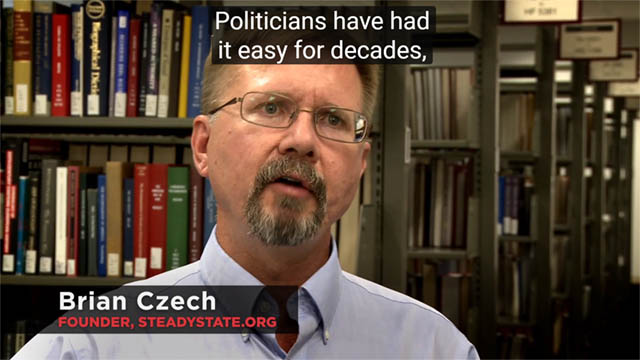 1:21:58
Brian Czech, founder Steadystate.org [Ph.D. in renewable natural resources studies from the University of Arizona with a minor in political science. The founding President of CASSE, also a Visiting Professor at Virginia Tech, where he teaches ecological economics in the National Capital Region. A prolific author in a variety of venues, his scientific articles have appeared in dozens of peer-reviewed journals, dealing primarily with ecological and economic sustainability issues]: Politicians have had it easy
for decades, especially when there were abundant natural resources,
because they could just talk about a rising tide lifts all boats. As
long as we have economic growth you don’t have to worry about a
fair distribution of wealth.
1:21:58
Brian Czech, founder Steadystate.org [Ph.D. in renewable natural resources studies from the University of Arizona with a minor in political science. The founding President of CASSE, also a Visiting Professor at Virginia Tech, where he teaches ecological economics in the National Capital Region. A prolific author in a variety of venues, his scientific articles have appeared in dozens of peer-reviewed journals, dealing primarily with ecological and economic sustainability issues]: Politicians have had it easy
for decades, especially when there were abundant natural resources,
because they could just talk about a rising tide lifts all boats. As
long as we have economic growth you don’t have to worry about a
fair distribution of wealth.
1:22:14 William Rees: So, for example, in North America, particularly in the last 40 years, by deliberate political choice we’ve emphasized the individual, selfish behavior, I’ve seen in a dozen newspaper articles how selfishness makes the world go around, and everybody else benefits if you’re as selfish as possible.
1:22:23 Goodall: And the argument is if we don’t consume then the attempts by people in poorer countries, Bangladesh, for example, to get out of poverty by building a textile industry, is disrupted. That is indeed the problem, and I think, I mean, I don’t, I don’t think there’s an easy answer to this. The fact is we cannot continue to support the attempts by Bangladesh to get it’s people out of poverty by setting up a textile industry. I think something like 90% of the exports of Bangladesh are processed cotton, in one form or another. So if you and I stop buying as many t-shirts it does affect the ability of people in that country to feed themselves.
1:23:16 Hans Rosling: Sometimes you see, I think that this, this concern about the environment, beside being real, it’s also like, a way to continue a belief that all people in the world will not live at the same level. That was always the belief in West Europe about other people. First we said they are racially subordinate, because they are stupid, genetically stupid. They cannot do it. And then when that convinced, they said, oh, no it’s culture, you know? They are Hindus, you know. They pray, and then they are Buddhists. The will never make it, you know. And now we say, oh yeah, okay, okay, they are genetically capable, and their religions can be compatible with a good [industrial society] life, but you know the environment doesn’t allow it. There’s always something, you know, and that’s why. And this with the environment is real, but people ain't going to exercise the option of dying today for the world to be better tomorrow. No one is going to do that [and no one gets a vote.]
1:24:24 Calhoun: The environment is just one problem which we’re focused on now, and this may be a real trap, because we only look at the physical, biological aspects of our surroundings. Where if we focused instead on what is a much more essential, comprehensive problem, and the designing of evolution.
[old video] Dr. Calhoun, I want to give you an opportunity to go back to something we touched on earlier, and that was you said, “Standing room only.” and you said you wanted to come back to it.
When certain tolerable limits are reached, this will set, will establish the necessity for controls. Now, among animals these controls are fairly automatic, and they go through the adrenal, the pituitary system.
1:25:10 : If a female, a pregnant female house mouse smells the odor of a strange mouse, a stranger, she reabsorbs her embryos. The embryos that are going inside her go into reverse, [whistles] and disappear. It’s an abortion of an extraordinary natural kind.
1:25:37 Adams: The rat populations would level off. The cities didn’t, the cities seemed to get more and more dense. Humanity, unlike the rats, didn’t seem to have this controlling capacity.
1:25:47 : Most animals have some sort of breeding control system. Why haven’t we got one? That’s the big question, because so far we haven’t evolved one.
1:26:00 [old video] Calhoun: If you start a population all crowded it manages to develop any identity, you develop any space bubble so that… [Man on right: Then you don’t need the] You don’t get aggressive. You don’t get anxiety, so nothing interrupts reproduction. And this is a trap that we could get into.
1:26:18 : If we have sufficient intelligence then that alone should be enough for us to control our population.
1:26:28 Wolfgang Pekny: Any programs against contraceptive measures are crimes against humanity, yeah? And I couldn’t understand how anyone, religious leaders, or so, seriously promote anti-contraception policies. That’s a crime against humanity.
1:26:49 Goodall: But more and more we seem to see the Catholic church, in particular, is holding back, trying to make sure that fertility rates stay high in these other countries. And that seems to me to be utterly wicked, and completely at variance with the moral principles that the church would otherwise say that it had.
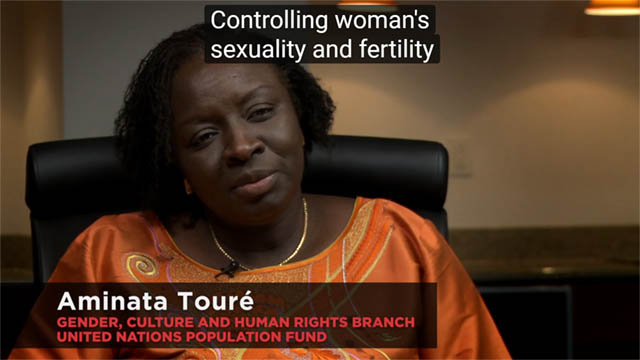 1:27:07
Aminata Toure, Gender, Culture and Human Rights Branch, United
Nations Population Fund [Senegalese politician, Served as the Prime Minister of Senegal from September 2013 until July 2014. Touré holds a PhD in International Business Administration and Finance and masters in Economics]: Controlling woman’s sexuality and
fertility has always been, you know, a big product of men who are in
power. And we can even see now when war happened the body of women is
still a battlefield, and that’s what we’re speaking to.
1:27:07
Aminata Toure, Gender, Culture and Human Rights Branch, United
Nations Population Fund [Senegalese politician, Served as the Prime Minister of Senegal from September 2013 until July 2014. Touré holds a PhD in International Business Administration and Finance and masters in Economics]: Controlling woman’s sexuality and
fertility has always been, you know, a big product of men who are in
power. And we can even see now when war happened the body of women is
still a battlefield, and that’s what we’re speaking to.
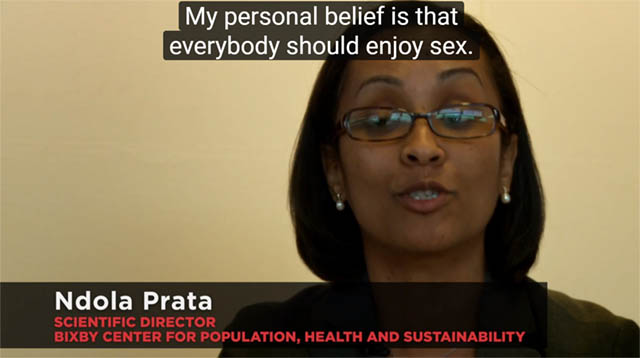 1:27:23
Ndola Prata, Scientific Director, Bixby Center for Population, Health
and Sustainability [public health physician and medical demographer from Angola]: My personal belief is that everybody should enjoy
sex. You just have to have the capacity to enjoy sex without
necessarily having to reproduce if you don’t want to.
1:27:23
Ndola Prata, Scientific Director, Bixby Center for Population, Health
and Sustainability [public health physician and medical demographer from Angola]: My personal belief is that everybody should enjoy
sex. You just have to have the capacity to enjoy sex without
necessarily having to reproduce if you don’t want to.
1:27:22 Toure: In some countries still now you cannot ask explicit family planning if your husband doesn’t write you a small note saying that he agrees. Or you have to succumb to the pressure of your mother-in-law, who would like to have more grandchildren. So it’s all about other’s desires, than women themselves.
1:27:53 Prata: It’s not easy to control fertility if you’re a poor woman in a village with a huge desire to do it, and sometimes what happens is that’s when they find themselves with an unwanted pregnancy. They go out of their way to try to terminate with huge consequences for their health, sometimes even death as a result of it.
1:28:17 Toure: If a woman cannot decide about her own sexuality, her own reproduction, where do we expect her to exercise her human rights? [Who is the giver of “rights”?]
1:28:24 Pekny: It takes three measures to get population growth down. First is empowerment of woman. Second is empowerment of woman. Third is empowerment of woman.
1:28:40 Cotton: And this, the empowerment of women is sort of almost like, well there you go then.
1:28:45 Martha Madison Campbell: And the reason I talk about women needing to take control with contraception instead of men is that women have a greater interest in having fewer children.
1:28:55 Cotton: In some people’s minds it means the disempowerment of men, you see.
1:28:58 Robert Engelman: There’s no way we can test future population growth, so it does make sense, really I think, to find ways to slow population growth that are consistent with our values. And I argue that trying to make sure that women don’t have unintended pregnancies is pretty consistent with, I think, just about everybody’s values.
1:29:16 Herman Daly: The more human beings the better, as long as they’re not all alive at the same time. You don’t want everybody alive at the same time. Why? Because if too many people are alive at the same time you overwhelm life support capacity and diminish it. What does that mean? That means fewer people are going to be alive in the future.
1:29:44 : We are a high quality species, we’re not a high quantity species. We shouldn’t be, we should be a high quality species, and we should actually think in terms of increasing the quality of life for everybody rather than the quantity of people alive on the planet.
1:29:59 Calhoun: We need better establishment to allow interrelationships to protect us from too many contacts, but to allow us, for those contacts which we do engage in to be more meaningful for our own lives, and more meaningful to others, in a compassionate sense of each of us being involved in helping the other to fulfill his role. We’ll have many more roles, and this is where the notion of compassion comes in as helping, each of us helping others to fulfill their programs for development.
1:30:34 Adams: I think he calls it a compassionate revolution. He has the sense that if people begin to get on better with one another, that’ll be the first steps towards dealing with these problems of elevated density.
1:30:47 Lowe: When enough people want change badly enough it happens regardless of how strong the forces are reigned against them.
1:30:54 Rosling: We have to make the wise and right decisions as mankind. And we ain't doing it now, but we are having the resources. We have enough sunshine, we have enough money, we have enough scientific capacity. We can do it.
1:31:09 Gary Marcos: You watch a movie, documentary, you are better informed. The question is, does that stay close enough to the forefront of your thinking to act on it? So people learn new information all the time, and there’s some evidence that human beings are actually becoming smarter and better informed than they used to be. That the average person knows much more, today knows much more than the average person did, say, 300 years ago. There’s a much bigger fund of general knowledge. People are generally better informed, partly because of the internet [“post-truth” is of recent coinage.] But that doesn’t necessarily mean that we act on that knowledge. So we have this really large body of background knowledge, but you still have to set your priorities about what you’re going to do, and the structure of the brain is those priorities are going to start with food, and move up to sex, and it’s going to be really hard to get people to worry about things like the fate of mankind.
1:31:55 David Korten: Most people who watch this video have some interest in some mutual fund, or retirement fund, or some kind of financial fund, presumably managed for their benefit. That fund owns assets around the world, but you have no idea what assets you own, you don’t know what people are involved. You don’t know how those people are treated. The only relationship you have to those assets is what is the financial return. So this becomes, in a sense, kind of the ultimate perversion of society, so that even those of us who are owners have no real idea what we own or what the implications are.
1L32:42 Goodall: We have, therefore, to run our lives, to take into account the impact on other people, whether it be our next door neighbor, or whether it be on the cotton farmer in central Asia. That means that we need to take responsibility. Capitalism says that all we need to do is worry about having enough money to buy the things that we want. No, we have moral obligations to live our lives to benefit the rest of humanity [what about Nature?], not just ourselves, financially.
1:33:09 Pekny: So, for the time being we have this one planet, and we have this, you name it, it doesn’t make a lot of difference. We have to divide what’s there by 7 billion, this year by 8 billion, by 9 billion middle of the century, yeah? And there you get your share of the planet, which is, plus, minus, one, to one and a half global hectares. So my challenge is, for my family, for my country is, how can we design our economies, our societies, our lifestyles, that we have a happy, descent, funny, fulfilling life within using my fair share of the planet.
1:33:51 Lowe: The future is not somewhere we’re going, it’s something we’re creating. So you shouldn’t ask the experts to tell you what the future will be like, you should ask yourself what do you want the future to be?
1:34:01 Calhoun: And the future, the entire future of evolution depends on the next 15 years. It’s the people here now, who’re involved now.
1:34:10 Adams: He had a positive message about the future of humanity being something that was in our hands, and that we ought to try and steer rather than let itself run adrift, in the way that the rat populations had.
1:34:25 : I’m convinced that a species that has been as successful as ours in the past will not fizzle out in a chaos of overpopulation. I just don’t believe that.
1:34:39 NARRATOR: As I was finishing this film some interesting headlines appeared in the news. “Japan’s population to fall by third in 50 years;” Japan’s population is predicted to fall by 1 million a year into the foreseeable future. By 2060 it will be two thirds the size it is now, with 40% of the population above retirement age. Are they leading the charge towards a stable population at a lower level? Or will their birth rate continue to drop to nothing, just like Calhoun’s rats? The idea of a shrinking population is discussed as if it is a catastrophe, usually for economic reasons. Modern economies are based on the idea that continuing population growth can service continuing debt growth which leads to continuing economic growth. It’s easy to become blinded by all the big numbers and percentages, by the projections and predictions. We are talking about people, and ultimately about the entire enterprise of life. What do we really want, a mirage of success based on theories and statistics, or the best possible human experience in balance with our planet and the rest of its inhabitants? As individuals, shouldn’t we strive to create societies which we believe in, not because they already existed when we were born, but because they are worth preserving? In the end, Calhoun’s rats were locked into a set pattern, unable to overcome the situation into which they had been put. As they circled the drain none of them were able to stand apart, to speak out, to help the others. They had lived for too long in constant struggle with one another and between their biology and their psychology, they gave up, and died out. Humans might not be rats, but that doesn’t mean we can’t learn from what happened to them. It means we have to do better.
1:36:33 From old video, man on right: Dr. Calhoun, as a human being, after going through this experiment what goes through your mind? Are you worried about the future of mankind?
1:36:35 John B. Calhoun: You are highly optimistic, at the same time highly pessimistic, and you wish to throw your weight, intellectual weight to moving towards the optimistic side, to opening up continuing evolution.
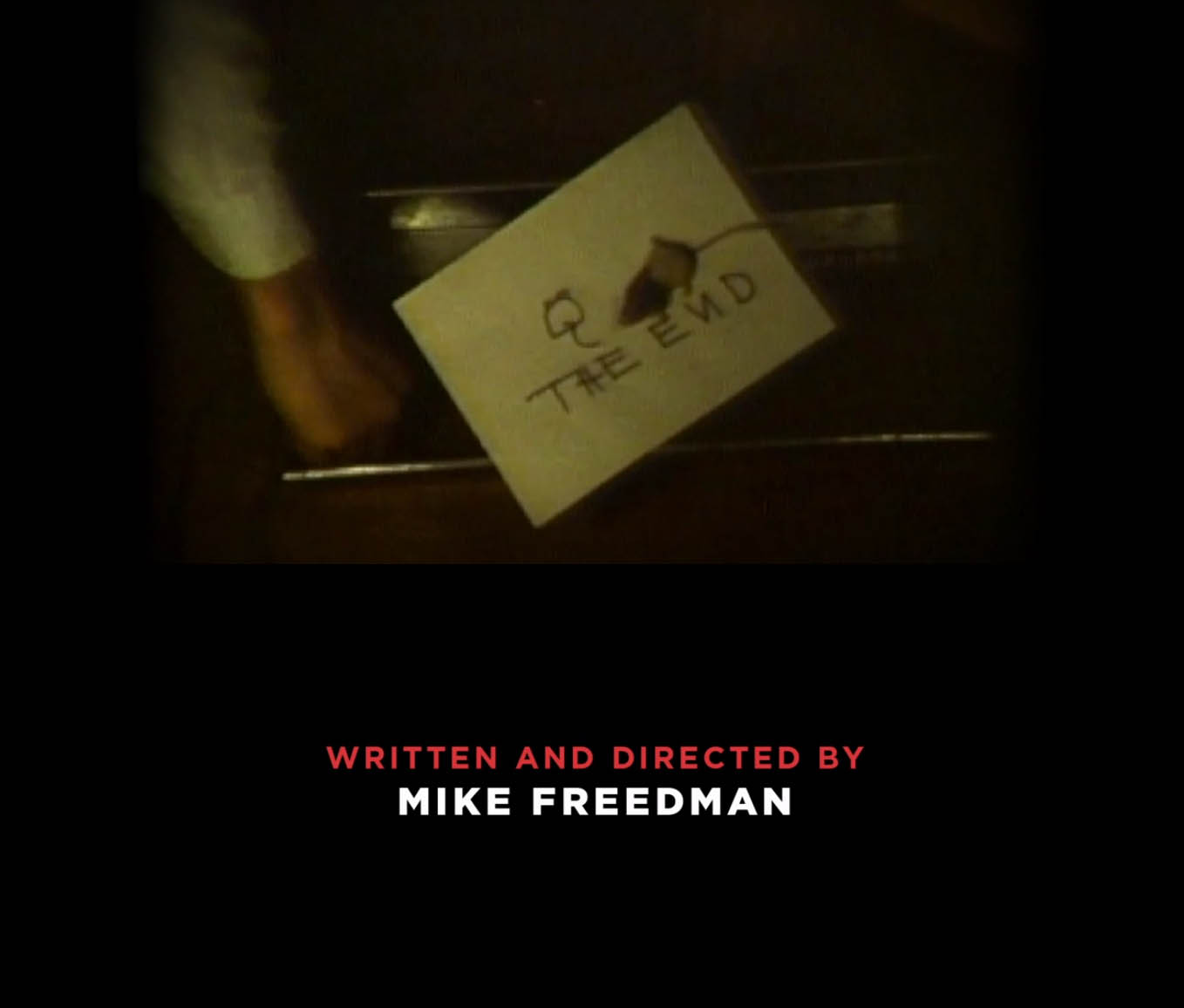
THE TRUTH!
As if humans could grasp it
Want 'the truth!'? Who doesn't?
"You iterate towards the truth. You don’t know it....eventually we'll have a human on the planet that really does understand it and can live with it properly. That's the source of my optimism." —James Lovelock, who exemplifies extreme optimism and pessimism (he thinks it possible/likely that humans will experience an 80% to 90% depopulation in the 21st century). If you cannot know anything (and therefore don’t), you can but iterate towards the truth/knowing.
Our ancestors, going back nearly 4 billion years, learned the hard way to live properly with the planet as Nature is unkind. Agriculture, and more recently fossil-fueled eMpowerment [the total eMergy/emergy flowing through a system during a certain period of time is called empower], has allowed us, for a time, to forget how to live properly on Earth in relationship with other organisms and the planetary environment/life-support system. We can relearn the hard way (renormalize) or go extinct.

Nature is unkind to they who cannot listen and learn. Listen [to Nature “who has all the answers”]. The only alternative is to learn, via foresight intelligence, to both understand and love this Earth and the things of it by listening to Nature.
Sometimes blindered heads steeped in willful ignorance make me want to swing the biggest rhetorical 2x4 I can find, but such has already been done by the likes of John B. Calhoun (in 1972, published 1973). He had concerns that many years of listening to Nature (especially in the form of rats and mice) had whispered to him in the form of data. We humans are in overnumeric and overdensity overpopulation, a condition that selects for 'dissolution' (a word that better sidesteps amygdala reactivity from hijacking human PFCs than the word 'extinction'). Perhaps modern humans seriously underestimate the difficulty of avoiding a ghastly future.• Our global socio-politico-economic system is NOT REMOTELY CLOSE TO SUSTAINABLE.
• We are captured and being dragged along by a complex, powerful and remorseless dynamic that automatically thwarts all attempts to stop it.
• If we don’t put time and energy into understanding it, we are doomed to go with it, right to the final curtain.(ref)
Death Squared
[in short, by John B. Calhoun, Death Squared, 1973,
and when you are ready, bend over and take it]
"Mortality, bodily death
= the second death
[the normal and necessary death of phenotypes
that
enables species, genomes, to be evolvable]
Drastic reduction of mortality
[18th to 21st century births>deaths,
resulting in an overshoot population]
= death of the second death
[failure to maintain population under carrying capacity,
resulting in posterity's death by overshoot debt]
= death squared
= (death)2
(Death)2 leads to dissolution of social organization
= death of the establishment
Death of the establishment leads to spiritual death
[loss of viable function]
= the first death
[functional behaviors are a precondition for evolvable
life
which comes first, so such death is a first death]
Therefore: (Death)2 = the first death.
[failure to renormalize, to recover a capacity to engage in behaviours essential
to species
survival,
is species extinction, first by a loss of societal functionality followed by posterity's bodily death]
We can only avoid the first death by managing, yet ultimately embracing, the second death (failure = first death/extinction). Such is wisdom and understanding. We may be a most promising species (or not).
We could evolve into Earth Guardians or go extinct. Such is the human predicament. Anyone who is not simultaneously extremely optimistic and pessimistic, is not thinking well about complex systems.
Now is the time for all good [still functional] humans to come to the aid of their species by understanding (becoming systems science literate) and loving the nature of things, Nature, Gaia, Aluna, the system and the SYSTEM (aka the Establishment whether working well or ill). Love and understand your Mother, the Mother of all life on Earth. "To think is to listen. Listen."
Humans of NIMH
[National Institute of Mental Health]

A compassionate ![]() evolution for compassionate
evolution for compassionate ![]() evolutionaries.
evolutionaries.
You can't join the compassionate ![]() volution, but you can be a compassionate
volution, but you can be a compassionate ![]() evolutionary.
evolutionary.
We really need prescriptions for our continued evolution.
In the 1990s an apathetic youth who was cynical and uninterested in economic, political or social causes was known as a slacker. As a recent convert in China notes "the term ‘let it rot’ [bailan] is similar to ‘lying flat’ but conveys a new degree of cynicism", "new slang terms are being coined to capture young people’s sense of doom and despondency". Urban youth unemployment in 2022 China was over 18%, so lying flat and letting it rot is adaptive, not a call for revolutionary change.
To consider social movements, perhaps reading/rereading Eric Hoffer's 'The True Believer' is a start. Movements are not ultimately belief-based, however (though expressed as beliefs). The pattern unfolding in China is secondary to China’s still mainstream intense ‘996’ work culture (working from 9am-9pm 6 days a week to grow the economy). Prior to China at present was Japan's post-WWII reconstruction, a corporate 'Made in Japan' work culture. America's 'Made in the USA' work culture, aka 'the rat race' was associated with the 'Great Acceleration' of about 1950 that led to a counter culture response in the late 1960s to a system making impossible demands on people to produce and consume as in China today.
Counter culture may be 'just the thing' needed (if it were actually a paradigm shift in a viable direction), but none have yet been counter enough. We may look at China's version of a counter/slacker culture and celebrate, but fail to see it as a loss of functional behaviors on a cultural (civilization overshoot?) downslope.
The 5% to 19% GDP growth was China's normal (2020 was 'only' 2.3% but back to an almost normal 8.1% in 2021) that will transition (unintended no doubt) to zero and beyond even if the year it does is unknown. A recognition that the 'Establishment' is non-viable does not seem to translate into becoming viable (though contrarians typically imagine a good outcome).
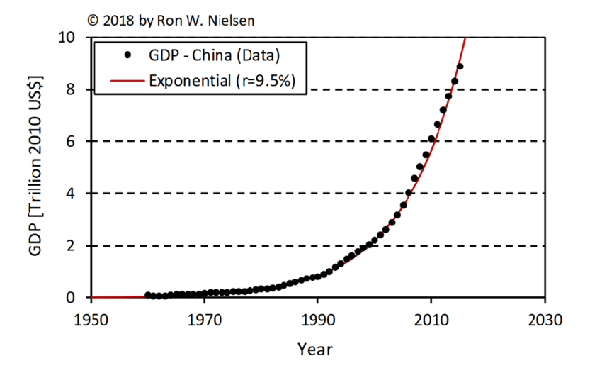
At 9.5%, China's economy doubled every 7.4 years. In one three year period they used more concrete than the USA had in its entire history.
Just by way of doing the 'let him declare what he seeth' thing, we are products of a culture that has replaced the 'life-driven purpose' of our ancestors (go forth and hunt/gather/forage as needed to persist) with a 'purpose-driven life' as servants, domesticants of overcomplex economies/empires/societies. We are perhaps not normal humans, but more like Skinner's rats in a Skinner box pressing levers. Doing what is needed each day to persist and prosper within carrying capacity limits (that Nature alone defines) as normal and functional K-strategists is what Nature selects for (a 4th law of energetics MPP thing).
In our monetary culture, working for money is selected for by the economy/society (which we misjudge 'the world' some would seek to 'save'). Doing so defines normalized behavior that to normal humans (all but recent ancestors) would appear insane, the starkest madness, as one might imagine wild rats would view the behavior of Skinner's and Calhoun's lab rats.
Using a variable schedule of reinforcement, I can get a rat to push a lever for food (energy) until it dies for lack of food/energy. Its last purposeful act, if the energy in the food reward is less than the energy required to keep on pushing the lever, will (before dying of starvation) be to press the lever one more time (as I would).
A rat's or a human's capacity to be reinforced while living in a state of nature is not a pathology (does not select for the animal's demise). Our condition of living in an overcomplex monetary society that selects for a purpose-driven life is not different in kind from rats in a Skinner box or Calhoun's rats of NIMH. The outcome is one those alive today are bearing witness to, even if few understand what they seeth.
Calhoun's concerns for posterity were derived entirely from listening to what his rats and mice were telling him for over forty years. That almost no one today shares his concerns doesn't mean they go away because they must be wrong. My concern is that humanity is seriously underestimating the challenge of passing through the foreseeable bottleneck, the Great Selection, sufficiently intact to persist long term as a viable species. And I hope I'm wrong about everything.
Calhoun's first experiment involved wild Norway rats, presumably full function normal K-strategist rats (not rats of NIMH) who had never been subject to overdensity living and loss of functional behaviors, and thus avoided overdensity population overshoot. Doing so is adaptive and has been selected for (in rats who have been a eusocial species far longer than humans who are not as highly evolved).
Calhoun released five female rats and enough males in a 10,800-square-foot (1000 m2) outdoor pen with predator exclosure and supplied them with illimitable (to them) food and water and such necessities as Calhoun (he wasn't a rat, so what would he know?) thought to provide. He observed them over a 28-month period starting in 1947 (Calhoun was forced to retire from NIMH in 1984 but continued to study his data until he couldn’t as he had a life-driven purpose to do so).
Per Calhoun's best guess their population could have theoretically grown to 5,000 rats in the enclosure (based on the density domestic rats tolerate), but didn't. Their population climaxed at about 200 and then stabilized at around 150. As noted, these were normal Norway rats with culture/behavioral repertoire intact. They did not disperse evenly about the enclosure as individuals, but self-organized into twelve or thirteen colonies of about 12 rats each. The Dunbar number for Norway rats is about 12, and the maximum viable colony density was about 12-13 for the size of area they inhabited. Stress between colonies, conflict/fighting, was evident.
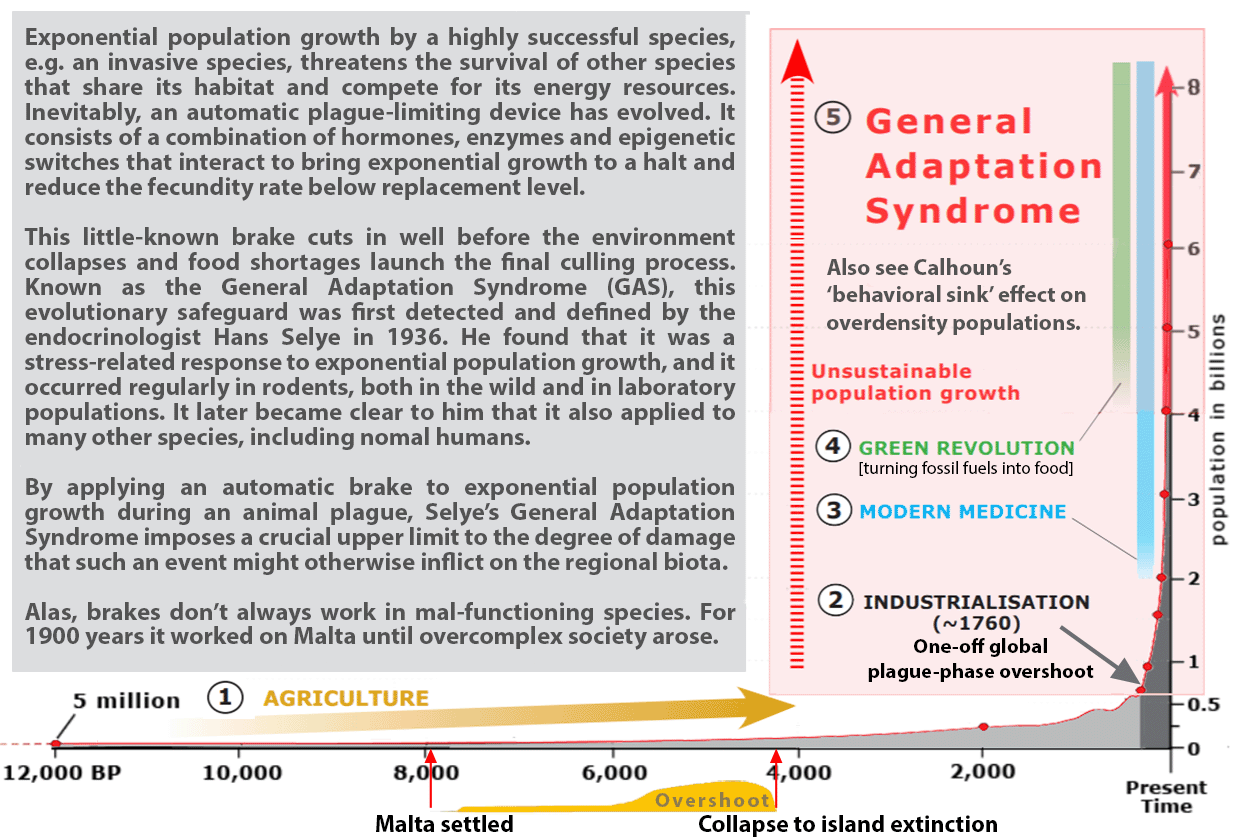
Humans domesticants differ from rats (but not in kind). Our Dunbar number is about 150, the maximum viable band size (though optimal is 20 to 50, 5-85 range). Normal humans, most of our ancestors for the last 375k years (until recently, over the last 75k years), maintained a viable population density and numbers within a biome as fully functional K-strategists. We modern techno-industrialized humans of NIMH are not normal. Normal K-strategists are not like us short-termers.
There is a limit to the number of rats in a viable colony, and a limit to the density of colonies, beyond which the colonies become too close together resulting in increasing stress just as beyond 12 rats/colony, more rats in a colony increases stress to a non-viable level.
Stress (GAS, General Adaptation Syndrome) is the limiter in populations of normal, functional rats and mice, beyond which conflict-based and disease-based mortality, and decreased fertility limit population (not the education and political empowering of female rats). 'Choosing' to not have children or marrying a hologram is not normal human behavior as viewed by our ancestors of the past 500 thousand years (or earlier).
Our problem is that we are not normal humans living on the veldt. Clever ape humans of NIMH we are (i.e. modern humans) and our technology and ability to concentrate energy flows (e.g. agriculture, use of horses, canoes) and living in overdensity populations (for a time) has grown in recent millennia. We who are pathogens living the pathogenic life cannot naturally limit what is already long into overshoot (a majority of humans were living unsustainably within an empire, from chiefdom to state level, when our global population exceeded about 35 million 3k-4k years ago).
Nature is unkind. Our condition of overshoot will be corrected. Whether some acquire enough foresight intelligence to manage our way down and manage a planetary commons by molding 'individual behaviour into a plan of actions or avoidances that are oriented toward the maintenance of a viable equilibrium between Man’s demands and Nature’s resources' is uncertain and perhaps unthinkable to us humans of NIMH. But at some point some may listen to their inner hominin and realize there really are too many of us and more BAU (business as usual) is going to be the death squared of us, we who are in double overshoot (ecological and civilizational).
At best we may hit what we aim for, e.g. renormalization of our psychosocial form and function to again become viable animals. Overestimating the challenge of civilizational paradigm change may be impossible. Underestimating the challenge may be part of our first death that locks in our (actually posterity's) death as a species. Life as we know it may be a dispensable distraction. In playing a high-stakes end game, keeping our eyes on the prize of persistence long term may be posterity's prize.
Of Mice and Humans
Calhoun’s non-mathematical, non-metaphorical (biblical) offering (conclusion) in prose:
For an animal so complex as man, there is no logical reason why a comparable sequence of events [exponential growth phase followed by loss of functional behaviours] should not also lead to species extinction. If opportunities for role fulfilment fall far short of the demand by those [the young] capable of filling roles, and having expectancies to do so, only violence and disruption of social organization can follow. Individuals born under these circumstances [modernity] will be so out of touch with reality as to be incapable even of alienation [of lying flat or letting it rot]. Their most-complex behaviours will become fragmented. Acquisition, creation and utilization of ideas appropriate for life in a post-industrial cultural-conceptual-technological society will have been blocked. Just as biological generativity in the mouse involves this species’ most complex behaviours, so does ideational generativity for man. Loss of these respective complex behaviours [condition of post-truth believing minds] means death of the species.
The Chemistry of Collapse
From “The Spirit in the Gene”, Reg Morrison, 1999, pages 130-134.
Many other animals seem to have a hormone-regulated response to environmental stress that switches their metabolism into a more economical mode whenever resources become scarce. Inevitably the energy-hungry processes of reproduction are the first to be targeted. For example, Australia’s kangaroos are able to put the development of their embryos on indefinite hold during drought by means of a unique, hormone-regulated phenomenon known as embryonic diapause. When the drought ends and food becomes readily available once more, the embryo resumes normal development. Wild populations of yellow baboons (Papio cynocephalus) have shown signs of hormone-regulated fertility decline during periods of social and environmental stress. The telltale hormonal signature of this process, first detected by endocrinologist Sam Wasser of the University of Washington, has also been identified in captive lowland gorillas, and in women. When persistent in women, it typically accounts for up to 10% of infertility and 25% of habitual abortion.
A similar hormonal signature with even more dramatic outcomes has been recognized in other species, notably snowshoe hares, lemmings, voles, rats, mice, and tree shrews. These animals, however, are more likely to become infertile during periods of social rather than environmental stress, and the primary governing factor seems to be population density. When the number of individuals rises to a certain level, a suite of internal factors, all hormone-regulated, appears to cut in, limiting fertility even where food resources remain unrestricted. This process has been shown to lead to a total cessation of reproduction in some cases, and occasionally leads to population extinction, although how this occurs is still poorly understood. The most startling feature of these collapses is that even when numbers had plummeted to the point that density was low and social stress was no longer a problem, instead of fertility rising and death rates falling to allow the population to recover, the decline accelerated.
General Adaptation Syndrome
This curious mechanism, originally called the general adaptation syndrome (GAS) by Hans Seyle, who first noted it in 1936, has since been reported in several wild rodent species, but it is best documented in laboratory rats. In well-fed but extremely dense populations, social stress appears to trigger a broad spectrum of abnormal physiological responses such as glandular malfunction, inhibited sexual maturation, diminished ovulation and implantation, inadequate lactation, increased susceptibility to disease, and a sharp rise in infant mortality. Social responses include increased aggression, infanticide and cannibalism, curtailed reproduction, abandonment of unweaned.
Some researchers have suggested that this general adaptation syndrome may in fact play a far more important role than in availability of food in the regulation of mammal plagues, since a curious feature of most plague collapses in the wild is the continued availability of food and the scarcity of malnourished corpses. The evolutionary value of such a mechanism would be considerable. If a plague species could cull its numbers before it totally exhausted its food resources, then it would avoid the risk of degrading its environment to the point that its extinction was guaranteed. [E.g. as modern humans are poised to do.]
Uninhibited by most of the estrous or seasonal factors that regulate reproduction rates in other mammal species, Homo sapiens seemed, until recently, to exhibit no trace of this syndrome and thus appeared to be biologically defenseless against exponential population growth. Wherever overcrowding coincided with high mortality rates (due to disease and malnutrition), fertility tended to accelerate, as parents tried to ensure against possible future family losses. Consequently, because of cultural factors and a peculiar ability to plan ahead, humans have tended to reproduce faster at precisely those times when the general adaptation syndrome might have been expected to come into play.
The Stress Connection
That appeared to be the case until the 1970s, when the East German scientist Gunter Dorner heard of the work of Selye and others on the physiological effects of social stress in laboratory rats and mice. Dorner had already spent much of his career investigating the role hormones such as estrogen and testosterone play in the development of the fetus, particularly in determining an individual’s sexual orientation. He was especially intrigued by reports that female rats subjected to severe social stress during pregnancy tended to produce male offspring that were attracted only to other male rats. Since he already knew that high stress levels experienced during pregnancy resulted in lower levels of male hormones in the womb, he decided to survey that section of the German population that had been born during and just after World War II to see if he could detect statistical evidence of the link between stress and sexuality in society at large. From the eight hundred homosexuals questioned in the survey, Dorner was able to determine that the homosexual birth rate (i.e., the percentage of homosexuals in the overall population) had indeed fluctuated according to the levels of stress suffered by women during pregnancy. More homosexuals had been born during the years of greatest social stress—during the last months of the conflict and those immediately following the war—than at any other time. In fact, two-thirds of the homosexual men and their mothers reported prebirth levels of stress ranging from “moderate” to “extreme,” and the stated causes included bombing, rape, and extreme anxiety. By contrast, only 10% of the heterosexuals in the control group reported unusual maternal stress during the prenatal period, and the mothers of these individuals reported only moderate prenatal stress.
Such a rise in the homosexual birth rate would of course have virtually no effect on the fertility potential of the German population as a whole, but that such a stress-related reproductive control mechanism existed in Homo sapiens at all was significant. The global fertility decline that developed so unexpectedly during the past two decades clearly suggests that we may, after all, be subject to multitude of subtle, larger fertility controls very like those that control rodent plagues. All the hormonal signatures are there, although it is impossible to discern at this early stage which forms of stress are primarily responsible for decline. Changes in lifestyle, self-administered recreational drugs and food additives, increased exposure to chemical pollutants that imitate or inhibit the body’s sex hormones—any or all of these, plus others as yet undetected, might be the trigger. We will no doubt continue to equate our declining fertility with cultural success and attribute it to the empowerment of women, effective sex-education programs, and the general spread of literacy and better information. But if you switch off the cultural soundtrack and concentrate on the figures and the population graph, it all looks astonishingly like the end of a typical mammal plague—and the beginning of Selye’s general adaptation syndrome.
The Enemy Within
Hormones move in mysterious ways their wonders to perform. As the body’s chemical messengers bring about adaptive physiological responses to environmental change. How elegantly appropriate it would be if, in chaotic and fractal fashion, they served precisely the same purpose on a global scale. Even manufactured substances that mimic hormones, a rogue element as far as we are concerned, may effect adaptive physiological changes. These substances, often called “endocrine disrupters,” disturb normal sexual development in a wide variety of vertebrates, including humans, causing lower sperm counts, undeveloped or malformed genitalia, repeated failure of embryo implantation, and a rising incidence of ectopic pregnancies. They occur in a vast range of commercial products—pesticides, plastics, paints, inks, industrial detergents—and are released as breakdown products. The onslaught of such substances was first brought to public attention in 1962 by Rachel Carson in her momentous book Silent Spring. However, she considered only the toxicity of such chemicals and was unaware of their even more serious long-term hormonal consequences.
Most of the known offenders imitate estrogen, and the impact is therefore most noticeable in males. Under the feminizing influence of these estrogen mimics, genes that are responsible for the production of testosterone in males often fail to switch on. Extensive surveys of male fertility carried out in several developed countries (notably Denmark, Scotland, and France) suggest that the average number of sperm in the ejaculate of a normal man appears to have fallen by up to 50% during the past fifty years. Although the method of analysis used in the surveys was widely criticized, similar sperm count reductions and increasing signs of sexual dysfunction have been detected in several other vertebrates, especially rats, alligators, and birds, and these too seem to have been caused by exposure to artificially produced hormone mimics. The matter was finally put beyond reasonable doubt in January 1997 when a Finnish team compared testicular tissue (taken during postmortem examinations) from men who died suddenly either in 1981 or 1991. In that ten-year period the numbers of men who had normal testicular tissue and healthy sperm production had fallen by more than 50%. As increasing numbers of artificial endocrine become interwoven with whatever endogenous fertility inhibitors constitute the human version of the general adaptation syndrome, it seems likely that the current fertility decline will gradually accelerate.
Driven by such subtle and complex chemistry, our ultimate population decline is likely to remain both inexplicable and beyond remedy. We will see a gradual increase in the incident of biological social dysfunction, as well as rising levels of unproductive sexual behavior, such as homosexuality, lesbianism, and pedophilia, and an increasing heterosexual tendency to postpone or avoid parenthood. The natural fertility brakes are likely to become even more pervasive and pronounced as population pressure increases, social cohesion decays, and environmental degradation mounts.
Although the global fertility rate is now showing signs of significant decline, judging by the current rate of industrialization, our energy consumption will multiply by a factor of 2.5 by the year 2050. The technological factor of the I=PAT equation (Impact = Population x Activity x Technology) thereby promises to compensate for most of the decline in population growth. In other words, as far as the biosphere is concerned, it is almost as though human fertility were not declining at all, suggesting that something other than simple math is manipulating the equation to achieve this convenient end. To lay the blame on human culture is circular reasoning and provides no answer, so we are left facing the intriguing alternative that our predicament betrays the presence of some form of evolutionary genetic management system, mechanism that has automatically locked us into a cultural development that guarantees disaster; perhaps even a Gaian mechanism like the one proposed by Vernadsky, Lovelock, and Margulis.
We Humans of NIMH (National Institute of Mental Health)
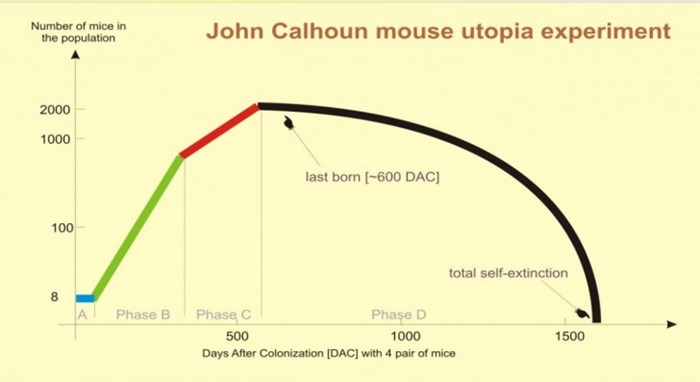 In his most famous experiment in the series, "Universe 25", population peaked at 2,200 mice. The normal behavior of Phase A was soon followed by increasing pathological behaviors that emerge in Phase B and C, and to fail the complex society in Phase D, ending when the last mouse died of old age.
In his most famous experiment in the series, "Universe 25", population peaked at 2,200 mice. The normal behavior of Phase A was soon followed by increasing pathological behaviors that emerge in Phase B and C, and to fail the complex society in Phase D, ending when the last mouse died of old age.
The mice increasingly exhibited a variety of abnormal sexual and aggressive behaviors as well as other self-destructive and other-destructive behaviors (conjecture: if the mice had access to recreational drugs, they would have used them...they would have played video games and spent nine hours a day on their smartphones if they could, and if the male "beautiful ones" had access to nail salons, they would have patronized them). By the 600th day, the population was on its way to extinction as their ability to successfully rear their young failed. Mouse generation time is 70 days, so decline began in generation 8.6 of the mice of NIMH experiment.
If the Industrial Revolution began in the period between 1760 and 1830 in European and American societies, then we are generation [(2019-1795)/25.5] 8.8 of our industrial society experiment. If industrial society were following the above pattern, then when did Phase C begin? Judging from the roar and conspicuous consumption, acceptance of unearned wealth beyond the dreams of avaricious as evidence of superiority and justification of privilege, then about the 1920s. Dickens and Conrad, among others, detailed the rise of our behavioral sink that may climax in the 21st century. The take-home message is that we may not be different in kind from other organisms (e.g. Dunbar's number for rats is 12, not 150, so we differ, but not in kind), nor is our complex system different in kind from other complex systems that select for an endgame (e.g. cancer).
"For the first time in history a conviction has developed among those who can actually think more than a decade ahead that we are playing a global endgame. Humanity's grasp on the planet is not strong. It is growing weaker. Our population is too large...." — Edward O. Wilson, Half Earth: Our Planet's Fight for Life 2016
Crazy
On the subject of Self as social construct, as belief-based concept/entity: Christopher Thomas Knight, also known as the North Pond Hermit, lived without significant human contact for 27 years between 1986 and 2013 in Maine.
He found contentment in solitude. He noted, "I did examine myself; it’s complicated. Solitude bestows an increase in something valuable. I can’t dismiss that idea. Solitude did increase my perception. But here’s the tricky thing—when I applied my increased perception [mindfulness?] to myself, I lost my identity. With no audience, no one to perform for, I was just there. There was no need to define myself; I became irrelevant. Years were meaningless. I measured time by the season and moon. The moon was the minute hand, the seasons the hour hand. I never felt lonely. My desires dropped away. I didn’t long for anything. I didn’t even have a name [he didn't know what he looked like as he had no mirror; couldn't lie, pretend, or deny; had no religious or political beliefs; didn't know the name of the pond he lived by...]. To put it romantically: I was completely free."
Free to follow the dictates of necessity, of his life-driven purpose. Freedom is total determinism, obedience to the nature of things, choiceless awareness, liberation from the dictates of belief-based storytelling including that of Self and Other. "Freedom is the recognition of necessity." —Garrett Hardin, 1968, in “Tragedy of the Commons,” the idea attributed to Hegel. And who's crazy?
Per the journalist (Finkel) who interviewed Knight, "Sometimes, when I’m driving in my car with my three kids fighting in the back and I’m late for an appointment, stuck in traffic and the radio is blaring bad news, a thought runs right through my heart and soul: It’s not Knight who’s crazy, it’s the rest of us. Maybe the operative question isn’t why Chris left society, but why the rest of us don’t."
If Knight is viewed as a sovereign individual, and 195 nation-states proclaim their sovereignty, then I would note that all are living a life of dependence on modern techno-industrial production and consumption. Knight could never spend money, and so did not value it. He was not by nature a thief and never justified his behavior by telling a story that he was not behaving badly.
But 195 nation-states are stealing from posterity and justifying it (thank you system serving intelligentsia). Knight stole what he needed to to survive. And 8 billion others do the same, except they take as much as they can and steal the rest. If all modern humans left the North Pond region, Knight would have had no propane bottles to steal nor food to eat. But with no people to discover his hide-away, he could have burned wood and made as much smoke as burning wood can sometimes make. He could have learned to fish, gather, and without humans in the area, like the Chernobyl Exclusion Zone, wildlife would soon become abundant. If some humans came to live in the area as hunter-gatherers, they would perhaps tolerate Knight's existence, or view him as a competitor and kill him.
Why do we live like rats in a Skinner Box? Oh, because that's what is selected for. Can the rules of the game, the contingencies of reinforcement, be changed? Perhaps if we stop listening to our self-serving stories (and those of all other self-serving storytellers), and listen to Nature instead, then we will change if we learn to listen to Mother (the Gaian system).
To follow the dictates of necessity as defined by Nature is "the life-driven purpose" our ancestors knew. Modern complex societies (exceeding Dunbar's Number) of the last ten thousand years, select for "the purpose-driven life" where purpose is defined by society via belief-based storytelling to generate behavior that serves it (the hierarchical control system and its technology that develops), turning humans into humans of NIMH such that in today's industrialized complex societies a quarter of the population will suffer from mental illness (per WHO) at some period of their lives if not the whole of it. A chronically over-active stress response induced by population density stress, the "diseases of civilization", could be causative.
Rats in a Skinner Box also live the purpose-driven life defined by the set and setting that define the "rules of the game". Those defining the criteria that determine mental illness must exclude themselves, and as dysfunction becomes more common, pathologies are normalized such that at the height of a humans of NIMH society where all are dysfunctional, most will be assessed as "normal" as population norms will define "normal" even if none are normal compared to "wild" humans (hunter-gatherer ancestors) not living the koyaanisqatsi life [conjecture: vastly exceed Dunbar's number and expect death2 in 8 to 12 generations of steady growth, whether of mice or men].
The believing mind, insanity squared, has been normalized. The process of denormalizing humans began about 55 thousands years ago with the Great Expansion out of Africa that led to a pulsing dynamic of empire-building. All prior complex societies rose, fell, or "faded away" with maybe one exception. A managed ecolate educational system could have a different outcome in a managed commons.
None of the rats of NIMH at maximum population were normal with respect to normal adaptive life-driven behaviors of wild rats. None of the eighth generation mice of NIMH were able to renormalize when removed from the high density population they were born and raised in any more than an eighth generation urbanized human could live in a hunter-gatherer society with or without a smartphone. We true believers, we denizens of industrial society wouldn't recognize what is "normal" if we were tossed into the midst of it.
Existential Concerns for Humanity and the Biosphere
Malthusian: Complex systems can select for their own failure via unmanaged pathological dynamics, (e.g. cancer, unmanaged commons, conquest culture, empire building). Any shortage of needed (or perceived as needed) energy or material resources (air, water, food, clothing, shelter, security, love and belonging, trust, role fulfillment, a place to stand—physical and memetic, and industrial energy/material inputs into the global economy that almost all now depend, for a time, on) creates conflict (human-human and human-environment).
Conflict consumes (reduces) energy and material resources that increase shortages (and the longage of demand), which increases conflict in a downward spiral to dissolution. Energy, the precondition for the flow of all other resources, cannot (other than short term) be created at will by clever apes. Nor will the Second Law (or 4th or 5th) go away by a consensus (belief-based certitude) that it does not apply to humans, who differ in kind from all other animals, as we decouple from Nature (an externality).
Calhounian: In proportion to the degree that the social group size exceeds the optimum [in humans 20-60 or < Dunbar's number of about 150 maximum. See Dyads: A Social Complexity Number.], dysfunctional behaviors increase from generation to generation as inappropriate species-specific activities increase such that "normal" individuals are no longer capable of executing the more complex behaviors compatible with species survival leading to a behavioral sink and death squared.
Only conflict and disruption of societal organization can follow. Individuals born under pathological biosociopolitical circumstances will be so out of touch with reality as to be incapable even of alienation. Their most complex behaviors will become fragmented. Acquisition, creation and utilization of ideas appropriate for life in a post-industrial cultural-conceptual-technological society will have been blocked.
Just as biological generativity in the mouse involves this species' most complex behaviors, so does memetic generativity for humans. Loss of these respective complex behaviors, including complex verbal behavior in humans (e.g. nearly universal post-truth denialism and belief in stories), means death of the species.
Whether the first death would mean a second death for all humans, or whether in perhaps 500 years of environmental and behavioral restoration (that will, a millennium or so later, come to be called dark age) is uncertain. That there will be humans in a post-hu-mans of NIMH world cannot be determined at this time, nor whether if extinction is sidestepped, that the remnant population has any viable, long-term future.
Ecological Trauma and Common Addiction
Rex Weyler, June 12, 2019
'Although modest and physically challenging, primal life offered certain benefits and shaped our nature. Early humans, like all animals, matured in stable communities with relatively secure food supplies. For millennia, families remained intact and children grew up watching parents work, surrounded by … the “more than human world” – the ultimate parent – learning lessons from the wild world, from creatures, and from landscapes .
These ecosystem comforts nourished us for 99.99 percent of our ancestral development. Then, only a few thousand years ago, some humans began living in [overdensity] urban environments, relying on remote agriculture, specialist skills, and the wiles of moneychangers [while forfeiting normal adaptive 'wild' behaviors to persist within a pathogenic monetary culture—for a time]. Within the last few hundred years, industrial culture has widened this separation from nature, divided families, and destroyed communities, creating alienated individuals clinging to scarce jobs and rewarded with packaged food and entertainment, like the “bread and circuses” that Roman emperors bestowed upon disenfranchised peasants.
In spite of our civilized ways, human psychology remains linked to our primal origins. We suffer the trauma of witnessing ecological abuse, watching our comforting wild home being destroyed, our relatives – owls, tigers,. gorillas – eradicated, and Earth diminished... “Beneath the veneer of civilization ... lies not the barbarian and the animal, but the human in us who knows what is right and necessary for becoming fully human.” ' [i.e. no longer humans of NIMH in maybe 8-12 generations.]
[So, 'go forth under the open sky, and list to Nature's teachings...' and 'seek out the condition now that will come anyway' for verily 'in Wildness is the preservation of the world'. Oh, and there are no political solutions.]
Population Density Stress Is Killing Us Now!
Gregg Miklashek, November 14, 2019
The following from STRESS R US: A 600+ page essay on what's killing us. why, and what we can do about it, 2017, the 'life's work' of Gregg Miklashek, neuro-psychiatrist and only human of NIMH I know of who has both Malthusian and Calhounian concerns.
- Our ancient stress response is chronically over-active ( COASTER ), which we came to see as a major component of “population density stress”, due to our built-world filled with population density stressors, our separation from Nature by the “built” world, and the loss of our ancestral Hunter-gatherer clan social structures. It is the chief contributing cause of nearly all current human illness.
- In animal models, a chronically overactive stress response (COASTER) appears to prevent overpopulation and “overshoot” of carrying capacity, as a result of disease promotion, reduced reproduction, and, finally, “the kill-switch”.
- Were it not for modern medical interventions, improved sanitation, waste management, water purification, and unsustainable natural resource extraction, the vast majority of us humans alive today would have been eliminated from our bursting populations many times over.
- We have been supporting our huge human populations by unsustainable, nonrenewable natural resource extraction for hundreds, if not thousands, of years and are reaching the point of totally exhausting earth’s ability to keep us alive.
- We cannot possibly morally or religiously justify our monopoly of earth’s resources to the exclusion of all other life-forms on the planet—the 6th mass extinction of all other life on earth.
- We are by nature highly social, nearly genetically identical clan social animals. The human population on Earth was stable at about 4-6-10 ( by varied estimates ) million when we thrived as clan-living hunter-gatherers. Clan living and the migratory lifeways necessitated constant contact with, and protection of, each-others’ children and
we kept our families small. We have lost this control today. - Only we humans, by individual action, can limit our family size to an average of one child, thus reducing world population size to 2.5 billion by 2100, and reduce our personal excessive consumption of natural resources. Recycle, join a resource sharing clan social group, reuse, buy local, support local organic agriculture; avoid all unnecessary petrochemical, plastic, electrical, and water use, etc., restoring balance to the ecosystem.
It is not already too late but immediate action is mandatory, if catastrophe is to be avoided. Population density stress is already killing us off, as Mother Nature intends when a species is overpopulated. It’s only a matter of time before we’re next to be eliminated by COASTER.
SUBNOTE TO FILE 1/3/23
"...the major contributors to social stress in cities are social density and social isolation, especially if they come with a low sense of environmental mastery in the individual, i.e. feeling capable of influencing the environment according to one’s own needs. Both variants of social stress – density and isolation – are well characterized health challenges: Social density can mean a constant threat for the social order we live in. Overcrowding can induce stress and illness in species ranging from insects to rodents to primates, including humans. And social isolation is associated with increased premature mortality – with a stronger effect than smoking, alcohol abuse or obesity." —Stress in the City
SUBNOTE TO FILE 3/27/24:
New Results Add to Old Ones
Be stressed, be very stressed over the increase in stress
The results of an unintended experiment 12 years ago were published two years ago, but too few were paying attention. Stress changes human brain s— as it has been since the beginnings of modernity, but more so during the last 75 years of exponential grow in stress during our Great Acceleration, compared to the last 75k years.
In 2012 Hurricane Sandy hit New York City, a rare event there, that significantly increased everyone’s stress level. A long term study of pregnant mothers was underway, so the outcome for those in Utero during the event, compared to those born before or conceived after, could be measured. The results are significant:
More than a decade later, she [a scientist] has her answer. The conclusions reveal a startling disparity: children who were in utero during Sandy bear an inordinately high risk of psychiatric conditions today. For example, girls who were exposed to Sandy prenatally experienced a 20-fold increase in anxiety and a 30-fold increase in depression later in life compared with girls who were not exposed. Boys had 60-fold and 20-fold increased risks of ADHD and conduct disorder, respectively. Children expressed symptoms of the conditions as early as preschool. — from The Guardian
Those who know of Gregg Miklashek’s work/findings had already heard the news, and those who still haven’t should read his free book.

